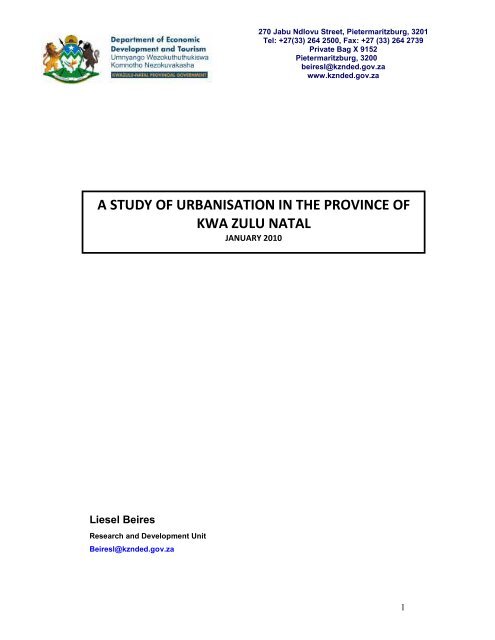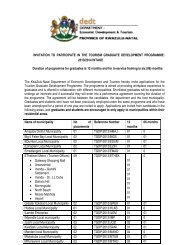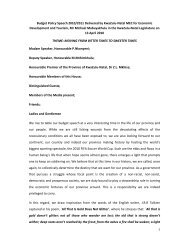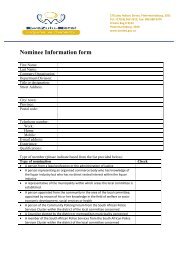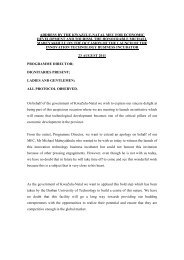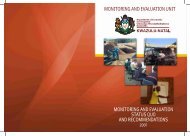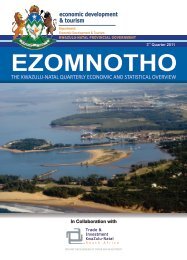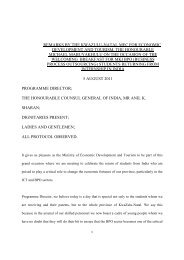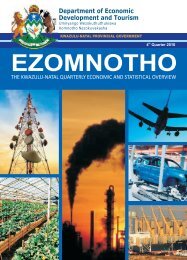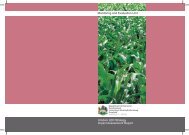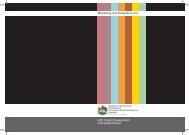a study of urbanisation in the province of kwa zulu natal
a study of urbanisation in the province of kwa zulu natal
a study of urbanisation in the province of kwa zulu natal
Create successful ePaper yourself
Turn your PDF publications into a flip-book with our unique Google optimized e-Paper software.
270 Jabu Ndlovu Street, Pietermaritzburg, 3201Tel: +27(33) 264 2500, Fax: +27 (33) 264 2739Private Bag X 9152Pietermaritzburg, 3200beiresl@kznded.gov.zawww.kznded.gov.zaA STUDY OF URBANISATION IN THE PROVINCE OFKWA ZULU NATALJANUARY 2010Liesel BeiresResearch and Development UnitBeiresl@kznded.gov.za1
It is <strong>the</strong> l<strong>in</strong>kages between <strong>urbanisation</strong> and economic development that provided <strong>the</strong> rationalefor this <strong>study</strong>. In <strong>the</strong> context <strong>of</strong> global trends and <strong>the</strong> vast literature that has been written on<strong>urbanisation</strong>, this <strong>study</strong> <strong>in</strong>tends to exam<strong>in</strong>e <strong>the</strong> <strong>in</strong>dicators for <strong>urbanisation</strong> with<strong>in</strong> <strong>the</strong> KZNprov<strong>in</strong>ce as well as to evaluate if <strong>the</strong>re has been a change <strong>in</strong> dwell<strong>in</strong>g location and type with<strong>in</strong><strong>the</strong> prov<strong>in</strong>ce.South Africa as a whole as well as KZN has experienced strong economic growth s<strong>in</strong>ce <strong>the</strong>1994 political change took place with<strong>in</strong> <strong>the</strong> country, up until this year where recessionaryconditions have taken hold <strong>of</strong> <strong>the</strong> economy. The evidence for this has been reflected <strong>in</strong> strongGross Domestic Product (GDP) performance, which <strong>in</strong> <strong>the</strong> last two years has been fluctuat<strong>in</strong>gbetween <strong>the</strong> 4-5% levels. In <strong>the</strong> years 2000-2003 <strong>the</strong> KZN GDP, grew at a higher rate than<strong>the</strong> national economy at a level between 3,5%-4,5%, while <strong>the</strong> national GDP grew between2,5% and 3,5% (Rob<strong>in</strong>s et al 2006). In <strong>the</strong> years post 2000 one has seen strong national andprov<strong>in</strong>cial performance <strong>in</strong> <strong>the</strong> residential, <strong>in</strong>dustrial, commercial and retail sectors <strong>of</strong> <strong>the</strong>property market. It is this background <strong>of</strong> strong economic and property performance that hasbegged <strong>the</strong> question <strong>of</strong> if <strong>urbanisation</strong> has <strong>in</strong>creased <strong>in</strong> KZN.LITERATURE REVIEW1.1 Def<strong>in</strong>itions <strong>of</strong> UrbanisationIf a simplistic def<strong>in</strong>ition <strong>of</strong> <strong>urbanisation</strong> is expressed it would be: “<strong>the</strong> <strong>in</strong>crease <strong>of</strong> a country’spopulation liv<strong>in</strong>g <strong>in</strong> urban areas” (Drescher et al, 2002). This can occur <strong>in</strong> one <strong>of</strong> two ways,ei<strong>the</strong>r due to an <strong>in</strong>crease <strong>in</strong> urban population as a result <strong>of</strong> natural population growth, or an<strong>in</strong>crease <strong>in</strong> urban population due to <strong>in</strong>ward migration from surround<strong>in</strong>g rural areas. Drescheret al (2002) <strong>in</strong>dicate that <strong>in</strong> <strong>the</strong> case <strong>of</strong> develop<strong>in</strong>g countries, <strong>the</strong> dom<strong>in</strong>ant factor that hasbeen driv<strong>in</strong>g <strong>urbanisation</strong> has been <strong>in</strong>creases <strong>in</strong> natural growth rates, ra<strong>the</strong>r than rural- urbanmigration. This is however not to say that rural -urban migration has not been a prolific force<strong>in</strong> develop<strong>in</strong>g countries’ <strong>urbanisation</strong> patterns. This is highlighted by <strong>the</strong> United Nations 2003report, which states that develop<strong>in</strong>g countries’ governments are more likely to <strong>in</strong>tervene nowthan <strong>in</strong> <strong>the</strong> past <strong>in</strong> <strong>the</strong> <strong>in</strong>ternal migration patterns <strong>in</strong>to metropolitan areas due to <strong>the</strong> perceivednegative consequences that this is hav<strong>in</strong>g on develop<strong>in</strong>g countries.Although 8 years old prelim<strong>in</strong>ary statistics released by Stats SA <strong>in</strong> 2001 <strong>in</strong>dicate that <strong>the</strong>prov<strong>in</strong>ce <strong>of</strong> KZN has a relatively low level <strong>of</strong> <strong>urbanisation</strong> <strong>of</strong> 45% compared to prov<strong>in</strong>ces suchas <strong>the</strong> Western Cape and Gauteng, which have <strong>urbanisation</strong> rates sitt<strong>in</strong>g at 90 & 96%respectively. In this regard KZN as a prov<strong>in</strong>ce still has a long way to go <strong>in</strong> its <strong>urbanisation</strong>process.3
There has been much debate that exists surround<strong>in</strong>g <strong>the</strong> dichotomous def<strong>in</strong><strong>in</strong>g <strong>of</strong> urban andrural areas. This is due to <strong>the</strong> difficulty that exists <strong>in</strong> sett<strong>in</strong>g out <strong>the</strong> factors, which allows oneto arrive at a dist<strong>in</strong>ction between rural and urban areas. Stats SA (2006) <strong>in</strong>dicate that <strong>the</strong>reare many areas that cannot unambiguously be def<strong>in</strong>ed as belong<strong>in</strong>g to ei<strong>the</strong>r a urban or ruralcategory, but ra<strong>the</strong>r fall somewhere <strong>in</strong> between. It is for this reason that Drescher et al (2002)<strong>in</strong>dicate that it is better to th<strong>in</strong>k <strong>of</strong> an urban –rural cont<strong>in</strong>uum exist<strong>in</strong>g, ra<strong>the</strong>r than def<strong>in</strong>itivecategories that make up ei<strong>the</strong>r urban or rural areas. Urbanization can be viewed as a dynamicprocess, where areas are cont<strong>in</strong>uously mov<strong>in</strong>g along a cont<strong>in</strong>uum <strong>of</strong> becom<strong>in</strong>g less rural tomore urbanised. Ledent (1982) expands on this thought process by <strong>in</strong>dicat<strong>in</strong>g that whenth<strong>in</strong>k<strong>in</strong>g <strong>of</strong> <strong>the</strong> <strong>urbanisation</strong> concept, <strong>the</strong> emphasis should not lie so much on <strong>the</strong> absolutegrowth <strong>of</strong> ei<strong>the</strong>r rural or urban areas, but ra<strong>the</strong>r on <strong>the</strong>ir relative growth.The idea <strong>of</strong> <strong>the</strong> cyclical nature <strong>of</strong> <strong>urbanisation</strong> is expanded by Zel<strong>in</strong>sky’s 1983 <strong>the</strong>ory <strong>of</strong>urban transition. This <strong>the</strong>ory is based on <strong>the</strong> similar cyclical pr<strong>in</strong>ciples <strong>of</strong> <strong>the</strong> demographictransition, which l<strong>in</strong>k economic cycles to population cycles. Zel<strong>in</strong>sky’s 1983 <strong>the</strong>oryhypo<strong>the</strong>sized that countries start from a low base where <strong>the</strong>re is a low proportion <strong>of</strong> <strong>the</strong>population that is urban and a low urban population growth rate. As a country goes through<strong>the</strong> development process this leads to higher urban growth. At <strong>the</strong> beg<strong>in</strong>n<strong>in</strong>g <strong>of</strong> this processurban growth is generally driven by migration <strong>in</strong>to urban areas whereas when an area isestablished <strong>the</strong> growth is ma<strong>in</strong>ta<strong>in</strong>ed by natural population <strong>in</strong>creases. In <strong>the</strong> later phases <strong>of</strong><strong>the</strong> urban transition a country should reach a stage <strong>in</strong> which it has a high proportion <strong>of</strong> itspopulation as urban but a low urban growth.Zel<strong>in</strong>sky (1983) notes that each country may follow <strong>the</strong> urban transition at its own pace andthat not every country will reach <strong>the</strong> same level <strong>of</strong> <strong>urbanisation</strong>. A country’s urban transitionmay follow different patterns due to <strong>the</strong> historical period it took place <strong>in</strong> and <strong>the</strong> level <strong>of</strong>economic development reached <strong>in</strong> a country.The <strong>the</strong>ories <strong>of</strong> urban transition as well as over<strong>urbanisation</strong> are important for this <strong>study</strong> as<strong>the</strong>y support <strong>the</strong> idea <strong>of</strong> <strong>urbanisation</strong> be<strong>in</strong>g dynamic and cyclical as well as emphasis<strong>in</strong>g that<strong>urbanisation</strong> is not a zero sum game. Tak<strong>in</strong>g <strong>the</strong>se <strong>the</strong>ories <strong>in</strong>to consideration one wouldhave to determ<strong>in</strong>e where <strong>in</strong> <strong>the</strong> cycle <strong>of</strong> <strong>urbanisation</strong> KZN prov<strong>in</strong>ce fits. Is one still see<strong>in</strong>glarge <strong>in</strong>flux from rural areas <strong>in</strong>to <strong>the</strong> major towns <strong>of</strong> KZN or are <strong>the</strong> towns grow<strong>in</strong>g ma<strong>in</strong>ly dueto natural <strong>in</strong>creases <strong>in</strong> population? The importance <strong>of</strong> historical context as was mentioned <strong>in</strong><strong>the</strong> urban transition <strong>the</strong>ory would also apply to KZN, due to <strong>the</strong> legacy that <strong>the</strong> policies <strong>of</strong>apar<strong>the</strong>id left beh<strong>in</strong>d.The United Nations (2001) cont<strong>in</strong>ues <strong>the</strong> debate regard<strong>in</strong>g <strong>the</strong> validity <strong>of</strong> hav<strong>in</strong>g an urban-rural dichotomy. They propose that urban-rural parts <strong>of</strong> countries are cont<strong>in</strong>uously becom<strong>in</strong>g<strong>in</strong>tegrated as a result <strong>of</strong> better transport and communication. This is result<strong>in</strong>g <strong>in</strong> <strong>the</strong> dist<strong>in</strong>ction4
etween rural and urban areas becom<strong>in</strong>g blurred. That is why <strong>in</strong> many studies and researchdone on urbanization <strong>the</strong>re has been a call to have three or fourfold classifications <strong>of</strong> areassuch as: rural, semi urban, peri urban and urban.In <strong>the</strong> case <strong>of</strong> South Africa, <strong>in</strong> <strong>the</strong> census run by Stats SA between <strong>the</strong> years 1980-1996, <strong>the</strong>only criterion used to establish if an area was urban or not, was that it had to be governed bysome sort <strong>of</strong> local government. Stats SA found it <strong>in</strong>creas<strong>in</strong>gly difficult to use this s<strong>in</strong>glecriterion s<strong>in</strong>ce 2000, which establishes <strong>the</strong> viewpo<strong>in</strong>t that a s<strong>in</strong>gle criterion cannot sufficientlydist<strong>in</strong>guish between rural and urban areas. The call for <strong>in</strong>creases <strong>in</strong> classification classes andvariables would allow for better results to be obta<strong>in</strong>ed <strong>in</strong> def<strong>in</strong><strong>in</strong>g <strong>urbanisation</strong> <strong>in</strong> a country orregion.It is evident from <strong>the</strong> above debate that <strong>the</strong> def<strong>in</strong>ition <strong>of</strong> <strong>urbanisation</strong> is not a simple science ifone wants to def<strong>in</strong>e it <strong>in</strong> its entirety. It is clear that its def<strong>in</strong>ition and its determ<strong>in</strong>ation <strong>in</strong> acountry or region is highly sensitive to time and classification variance.1.2 The forces that determ<strong>in</strong>e UrbanisationIn def<strong>in</strong><strong>in</strong>g <strong>urbanisation</strong> it was established that it is a dynamic and cyclical process. However,a better understand<strong>in</strong>g is needed <strong>of</strong> <strong>the</strong> forces that determ<strong>in</strong>e why <strong>urbanisation</strong> takes place.The simplistic def<strong>in</strong>ition <strong>of</strong> <strong>urbanisation</strong> <strong>in</strong>dicated that it was <strong>the</strong> <strong>in</strong>crease <strong>of</strong> a country’spopulation liv<strong>in</strong>g <strong>in</strong> urban areas. The key to <strong>the</strong>se urban areas and <strong>the</strong>refore to <strong>the</strong> whole<strong>urbanisation</strong> topic is <strong>the</strong> idea <strong>of</strong> cities. There has been much attention given <strong>in</strong> <strong>the</strong> literatureas to what cities are and what <strong>the</strong>y are not. Ballard (2002) <strong>in</strong>dicates that cities provided <strong>the</strong>context for an enabled western, modern first world civilised way <strong>of</strong> life to progress. Most<strong>the</strong>refore saw cities as <strong>the</strong> paramount ideal for <strong>the</strong>ir society. It is this viewpo<strong>in</strong>t that has driven<strong>the</strong> motion <strong>of</strong> <strong>urbanisation</strong> as human be<strong>in</strong>gs throughout <strong>the</strong> centuries for numerous economic,psychological and environmental reasons have chosen to cluster <strong>the</strong>ir activities toge<strong>the</strong>r.Alig et al (2003) <strong>in</strong>dicate that <strong>the</strong>re are six forces that shape and <strong>in</strong>fluence urban expansion:1.) The effects <strong>of</strong> <strong>the</strong> natural environment2.) The force <strong>of</strong> demographics3.) The effect <strong>of</strong> <strong>the</strong> economy. The specific elements mentioned <strong>in</strong> <strong>the</strong>ir discussion asbe<strong>in</strong>g key sources <strong>of</strong> <strong>in</strong>fluence on <strong>urbanisation</strong> are those <strong>of</strong>: household <strong>in</strong>come, level<strong>of</strong> FDI, real estate markets and on a larger scale <strong>the</strong> exposure to globalisation.4.) The role <strong>of</strong> transport and <strong>the</strong> efficiency <strong>of</strong> <strong>the</strong> transport systems <strong>in</strong> allow<strong>in</strong>g people tomove out <strong>of</strong> <strong>the</strong> CBD and establish what are known as commuter zones.5
5.) The trade <strong>of</strong>f <strong>of</strong> consumer preferences for proximity to amenities and places <strong>of</strong> workcompared with <strong>the</strong> type <strong>of</strong> lifestyle that <strong>in</strong>dividuals and families are after.6.) The effect <strong>of</strong> government <strong>in</strong> shap<strong>in</strong>g how <strong>urbanisation</strong> takes shape, by <strong>the</strong> policiesthat are implemented.What emerges from <strong>the</strong> above mentioned six po<strong>in</strong>ts is that <strong>urbanisation</strong> is governed bypolitical, economic and demographic forces. The process <strong>of</strong> <strong>urbanisation</strong> is one that has bothmacro and micro forces that play pivotal roles <strong>in</strong> determ<strong>in</strong><strong>in</strong>g what path it is to take <strong>in</strong> aparticular country or region.1.3 Post Modern Urbanisation and <strong>the</strong> impacts <strong>of</strong> sub<strong>urbanisation</strong> anddecentralisation.In consider<strong>in</strong>g so called recent <strong>urbanisation</strong> <strong>the</strong>ories; it is evident that <strong>the</strong> ideas presented <strong>in</strong><strong>the</strong> post modernist papers regard<strong>in</strong>g <strong>urbanisation</strong> cannot be ignored. One <strong>of</strong> <strong>the</strong> clear issuesthat emerge from <strong>the</strong>se writ<strong>in</strong>gs is <strong>the</strong> debate that surrounds <strong>the</strong> causes and consequences<strong>of</strong> decentralisation and sub<strong>urbanisation</strong>.Post modernist <strong>urbanisation</strong> writ<strong>in</strong>gs can be def<strong>in</strong>ed as <strong>the</strong> summarized depiction <strong>of</strong> <strong>the</strong> majorchanges that have been tak<strong>in</strong>g place <strong>in</strong> cities dur<strong>in</strong>g <strong>the</strong> last quarter <strong>of</strong> <strong>the</strong> twentieth century.Soja (1994) who bases his work on a case <strong>study</strong> done <strong>in</strong> <strong>the</strong> city <strong>of</strong> Los Angeles <strong>in</strong>dicates that<strong>the</strong>re are five geographies <strong>of</strong> postmodern <strong>urbanisation</strong>. The first one is that <strong>of</strong>de<strong>in</strong>dustrialisation and re<strong>in</strong>dustrialisation. Soja (1994) mentions that <strong>in</strong> recent economictimes <strong>the</strong>re has been a shift away from <strong>in</strong>dustry and more focus given to <strong>the</strong> service sectorand tertiary functions. This has led to <strong>the</strong> growth <strong>of</strong> what is known as <strong>the</strong> FIRE sector(f<strong>in</strong>ance, real estate and <strong>in</strong>surance). These activities can be placed <strong>in</strong> outly<strong>in</strong>g areas <strong>of</strong> citiesand <strong>the</strong>refore have added to <strong>the</strong> trend <strong>of</strong> suburban growth and decentralisation.The second is given <strong>the</strong> term <strong>of</strong> “glocalisation”, which is supposed to convey <strong>the</strong> idea that onehas had <strong>the</strong> globalisation <strong>of</strong> <strong>the</strong> local and <strong>the</strong> localisation <strong>of</strong> <strong>the</strong> global tak<strong>in</strong>g place. Thebackground to this geography is <strong>the</strong> much talked about spread <strong>of</strong> globalisation <strong>in</strong> recenttimes. This has been driven by <strong>the</strong> advancements <strong>in</strong> technology and communications, whichresulted <strong>in</strong> <strong>the</strong> compression <strong>of</strong> time and space, as well as <strong>the</strong> development <strong>of</strong> a world ‘culture’that permeates <strong>in</strong>to all regions <strong>of</strong> <strong>the</strong> globe. The place where this is played out is <strong>in</strong> cities.There has been <strong>the</strong> formation <strong>of</strong> a global system <strong>of</strong> ‘world cities’, as cities on a world scalecompete aga<strong>in</strong>st each o<strong>the</strong>r to attract activities to <strong>the</strong>ir shores. These activities may take <strong>the</strong>form <strong>of</strong> tourist events, headquarters <strong>of</strong> mult<strong>in</strong>ational companies or <strong>in</strong>ternational sport<strong>in</strong>gevents.6
The idea presented by Soja (1994) is that each city has taken a bit <strong>of</strong> <strong>the</strong> global culture andmade it local. Cities today <strong>the</strong>refore have heterogenous populations and heterogenouseconomic activities, with many <strong>of</strong> <strong>the</strong> companies and headquarters resid<strong>in</strong>g <strong>in</strong> cities be<strong>in</strong>gglobal operations. In many <strong>in</strong>stances this sp<strong>in</strong> <strong>of</strong>f from globalisation has given rise to <strong>the</strong>concept <strong>of</strong> dual cities, which are a mixture <strong>of</strong> third world and first world cities. This arises out<strong>of</strong> a situation where large global companies, which are support<strong>in</strong>g a grow<strong>in</strong>g globalbourgeoisie, locate <strong>in</strong> third world locations to make use <strong>of</strong> <strong>the</strong> abundant pools <strong>of</strong> cheap labour<strong>in</strong> <strong>the</strong>se locations. This has resulted <strong>in</strong> many third world cities hav<strong>in</strong>g a very rich and poorcomponent to <strong>the</strong>m. This impact although as a result <strong>of</strong> globalisation is not a new factor <strong>in</strong>cities. Benabou (1993) quotes Plato as say<strong>in</strong>g that: “Every city, no matter how small, is <strong>in</strong> factdivided <strong>in</strong>to two, one <strong>the</strong> city <strong>of</strong> <strong>the</strong> rich, <strong>the</strong> o<strong>the</strong>r <strong>the</strong> city <strong>of</strong> <strong>the</strong> poor.” There is a cyclicalpattern to be observed <strong>in</strong> this regard as previous spatial divisions <strong>in</strong> <strong>urbanisation</strong> patternsbetween <strong>the</strong> rich and poor will impact future spatial divisions.The third geography is entitled decentralisation and recentralisation by Soja (1994), <strong>in</strong> that he<strong>in</strong>dicates that today’s cities are simultaneously be<strong>in</strong>g turned <strong>in</strong>side out. This is as a result <strong>of</strong><strong>the</strong> rapid <strong>urbanisation</strong> <strong>of</strong> suburbs that has taken place. This has caused a breakdown <strong>of</strong> <strong>the</strong>traditional density gradients <strong>in</strong> cities, due to <strong>the</strong> mass exodus out <strong>of</strong> <strong>the</strong> CBD’s. This <strong>in</strong> turnhas caused projects to be implemented that try and attract people back to <strong>the</strong> CBD’s, such as<strong>the</strong> gentrification movement. The impacts <strong>of</strong> this will be discussed later on <strong>in</strong> <strong>the</strong> chapter.The fourth geography addresses <strong>the</strong> changes <strong>in</strong> social structures that are tak<strong>in</strong>g place with<strong>in</strong>cities. Due to <strong>the</strong> rapid sub<strong>urbanisation</strong> that has taken place <strong>in</strong> many cities one has had newpatterns <strong>of</strong> social fragmentation and polarization tak<strong>in</strong>g place. This has caused a widen<strong>in</strong>ggap both socially and spatially between <strong>the</strong> wealthy and <strong>the</strong> poor with<strong>in</strong> cities. This relatesback to earlier discussions surround<strong>in</strong>g <strong>the</strong> issues that <strong>urbanisation</strong> does not always havepositive impacts and <strong>the</strong>refore is a process that needs to be monitored.The fifth geography mentioned by Soja (1994) is <strong>the</strong> idea <strong>of</strong> <strong>the</strong> carceral city or city <strong>of</strong>imprisonment. He states that today’s cities have <strong>in</strong> many <strong>in</strong>stances become ungovernable,especially <strong>in</strong> relation to crime and unregulated <strong>in</strong>habitants. This has restructured urban spacedue to <strong>the</strong> rapid <strong>in</strong>creases <strong>of</strong> fortified spaces. These take <strong>the</strong> form <strong>of</strong> gated communities orwalled villages, which have a predom<strong>in</strong>ance <strong>of</strong> surveillance and security. This aspect <strong>of</strong> cityliv<strong>in</strong>g fur<strong>the</strong>r enhances <strong>the</strong> segregationist tendencies <strong>of</strong> <strong>urbanisation</strong>, as well as enhanc<strong>in</strong>g<strong>the</strong> divide between <strong>the</strong> haves and <strong>the</strong> haves not. This has to a certa<strong>in</strong> extent driven <strong>the</strong>movement <strong>of</strong> sub<strong>urbanisation</strong> as people try and escape <strong>the</strong> perceived <strong>in</strong>secure <strong>in</strong>ner cityliv<strong>in</strong>g. This aspect <strong>of</strong> <strong>urbanisation</strong> is particularly evident <strong>in</strong> South African and KZN cities, as <strong>in</strong><strong>the</strong> last few years one has seen <strong>the</strong> rapid development <strong>of</strong> security estates and gatedcommunities. In <strong>the</strong> E<strong>the</strong>kw<strong>in</strong>i Municipality alone one has seen a rapid <strong>in</strong>crease <strong>in</strong> gatedcommunities <strong>in</strong> Umhlanga, Hillcrest and Westville.7
The evidence <strong>of</strong> <strong>the</strong>se five post-modernist geographies is prevalent <strong>in</strong> many cities today, aswell as <strong>in</strong> South African cities. In South African cities <strong>the</strong> geographies <strong>of</strong> <strong>the</strong> carceral cities, aswell as spatial divides between rich and poor are particularly evident. As economic maturationhas occurred <strong>in</strong> <strong>the</strong> South African economy one has also seen <strong>the</strong> rise <strong>in</strong> importance <strong>of</strong> <strong>the</strong>tertiary <strong>in</strong>dustries, which have driven <strong>the</strong> decentralisation movement, especially <strong>of</strong> <strong>the</strong> <strong>of</strong>ficesectors. These broad post modernist <strong>urbanisation</strong> trends give a good background to this<strong>study</strong> as it gives a framework <strong>in</strong>to which one can place <strong>the</strong> observed trends <strong>in</strong> <strong>urbanisation</strong> <strong>in</strong>KZN.Geyer & Kantuly (1996) gave birth to <strong>the</strong> <strong>the</strong>ory <strong>of</strong> differential <strong>urbanisation</strong> <strong>in</strong> an attempt toexpla<strong>in</strong> migration patterns with<strong>in</strong> cities. Their <strong>the</strong>ory hypo<strong>the</strong>sizes that with<strong>in</strong> cities one hasmigration ma<strong>in</strong>streams and substreams, which supplement each o<strong>the</strong>r and <strong>of</strong>ten operate <strong>in</strong>opposite directions. They <strong>in</strong>dicate that <strong>the</strong> poor people tend to migrate to stronger economiccentres, which supports <strong>urbanisation</strong> while more wealthy people prefer <strong>the</strong> environmentalquality <strong>of</strong> smaller settlements support<strong>in</strong>g sub<strong>urbanisation</strong>. The prevalence <strong>of</strong> one processover ano<strong>the</strong>r depends ma<strong>in</strong>ly on <strong>the</strong> structure <strong>of</strong> society and <strong>the</strong> residential preferences. Forexample if a society were rich or young <strong>the</strong>re would be a high probability <strong>of</strong> sub<strong>urbanisation</strong>tak<strong>in</strong>g place <strong>in</strong> that region. This <strong>the</strong>ory would be an accurate description <strong>of</strong> <strong>the</strong> <strong>in</strong>ternalprocesses <strong>of</strong> <strong>urbanisation</strong> that are shap<strong>in</strong>g most cities today.Madden (2000) supports <strong>the</strong> <strong>the</strong>ory <strong>of</strong> differential <strong>urbanisation</strong> by stat<strong>in</strong>g that <strong>in</strong>trametropolitan shifts <strong>in</strong> <strong>the</strong> location <strong>of</strong> higher <strong>in</strong>come people to <strong>the</strong> suburbs <strong>in</strong>creases <strong>the</strong>concentration <strong>of</strong> <strong>the</strong> poor <strong>in</strong> cities. Therefore ris<strong>in</strong>g <strong>in</strong>ner city poverty rates are due to <strong>in</strong>comeselective sub<strong>urbanisation</strong> <strong>of</strong> metropolitan residents. The susta<strong>in</strong>ability <strong>of</strong> this form <strong>of</strong><strong>urbanisation</strong> is debateable. Madden (2000) <strong>in</strong>dicates that sub<strong>urbanisation</strong> results <strong>in</strong> an<strong>in</strong>creased pace <strong>of</strong> new construction <strong>of</strong> hous<strong>in</strong>g and <strong>in</strong>frastructure on <strong>the</strong> outer reaches <strong>of</strong>metropolitan areas, which encourages more people to move <strong>the</strong>re, which <strong>in</strong> turn adds tocongestion problems. Once aga<strong>in</strong> we have a clear example <strong>of</strong> this happen<strong>in</strong>g <strong>in</strong> <strong>the</strong> HillcrestSuburb <strong>in</strong> <strong>the</strong> E<strong>the</strong>kw<strong>in</strong>i Municipality <strong>of</strong> KZN. Over <strong>the</strong> last 10 years <strong>the</strong>re has been suchrapid expansion <strong>in</strong> hous<strong>in</strong>g estates <strong>in</strong> <strong>the</strong> area that <strong>the</strong> <strong>in</strong>frastructure has not been able tocope with <strong>the</strong> <strong>in</strong>creased load. This led to a moratorium be<strong>in</strong>g put <strong>in</strong> place on all developmentfor a 1-2 year period. It is now an area which suffers from heavy congestion problems.Madden states that <strong>the</strong> movement <strong>of</strong> higher <strong>in</strong>come populations from central and <strong>in</strong>nersuburbs affects <strong>the</strong> quality <strong>of</strong> life for both central city and suburban residents and raisesissues <strong>of</strong> equity and fairness. He also <strong>in</strong>dicates that <strong>the</strong> concentration <strong>of</strong> <strong>the</strong> poor <strong>in</strong> <strong>the</strong> largecentral cities threatens <strong>the</strong> economic productivity and competetiveness <strong>of</strong> cities and <strong>the</strong>reforeendangers national prosperity. He supports this argument by quot<strong>in</strong>g studies that have shownthat large Metropolitan areas that cannot fully utilize <strong>the</strong> <strong>in</strong>frastructure and <strong>the</strong> locationadvantages <strong>of</strong> <strong>the</strong>ir large central cities have lower productivity and earn<strong>in</strong>gs.8
One <strong>of</strong> <strong>the</strong> spatial results that have arisen from <strong>the</strong> process <strong>of</strong> decentralization andsuburbanization is <strong>the</strong> development <strong>of</strong> what has been termed ‘edge cities’. Anas et al (1997)describe edge cities as large concentrations <strong>of</strong> <strong>of</strong>fice and retail space as well as residentialdevelopments. They also <strong>in</strong>dicate that <strong>in</strong> most cases <strong>the</strong> <strong>in</strong>itial design and construction <strong>of</strong> anedge city was <strong>the</strong> product <strong>of</strong> a s<strong>in</strong>gle development company or <strong>in</strong>dividual. In <strong>the</strong> prov<strong>in</strong>ce <strong>of</strong>KZN one has a classic example <strong>of</strong> what an edge city entails <strong>in</strong> <strong>the</strong> form <strong>of</strong> <strong>the</strong> node <strong>of</strong>Umhlanga. This node conta<strong>in</strong>s premium retail, <strong>of</strong>fice and residential space and has beendeveloped as <strong>the</strong> result <strong>of</strong> Tongaat Hullett developers. Tongaat Hullett had <strong>the</strong> means and <strong>the</strong>ownership <strong>of</strong> land to develop a node that was modelled on <strong>the</strong>ir concept <strong>of</strong> New Urbanism,which entails creat<strong>in</strong>g space where people can “work, live and play”.Anas et al (1997) <strong>in</strong>dicate that <strong>the</strong> phenomenon <strong>of</strong> edge cities has been made possible by <strong>the</strong>ubiquitous automobile access <strong>in</strong> <strong>the</strong> last two centuries. The impact <strong>of</strong> cheapen<strong>in</strong>g cars onresidential decisions has become an important factor <strong>in</strong> <strong>the</strong> spread <strong>of</strong> cities and <strong>the</strong> process<strong>of</strong> sub<strong>urbanisation</strong>. This can be l<strong>in</strong>ked <strong>in</strong> with <strong>the</strong> earlier discussions regard<strong>in</strong>g <strong>the</strong>sub<strong>urbanisation</strong> <strong>of</strong> higher <strong>in</strong>come people. Those earn<strong>in</strong>g more are <strong>in</strong> a position to haveaccess to private transport, which <strong>in</strong> turn provides <strong>the</strong>m with <strong>the</strong> means to live <strong>in</strong> suburbs andbecome commuters. There is a trade <strong>of</strong>f that exists for commuters <strong>in</strong> this situation, <strong>in</strong> that asone’s <strong>in</strong>come <strong>in</strong>creases so does <strong>the</strong> value <strong>of</strong> one’s time. Therefore because commuters live <strong>in</strong><strong>the</strong> outer skirts <strong>of</strong> <strong>the</strong> city and are dependent on private transport <strong>the</strong>y would face morecongestion, which is an externality that arises because <strong>the</strong> user <strong>of</strong> a motor vehicle does notpay for its marg<strong>in</strong>al contribution to congestion. Commuters <strong>the</strong>refore have to trade <strong>of</strong>fperceived <strong>in</strong>creases <strong>in</strong> liv<strong>in</strong>g conditions <strong>in</strong> <strong>the</strong> suburbs with <strong>in</strong>creased time spent <strong>in</strong>congestion.The issue <strong>of</strong> transportation <strong>in</strong> <strong>the</strong> process <strong>of</strong> <strong>urbanisation</strong> and city development is animportant discussion. Anas et al (1997) <strong>in</strong>dicate that understand<strong>in</strong>g <strong>the</strong> forces <strong>of</strong> <strong>in</strong>formation,transportation and communication will enable one to understand newly emerg<strong>in</strong>g forms <strong>of</strong>urban structure. This is because advances <strong>in</strong> transport and communication have shaped <strong>the</strong>spatial structure <strong>of</strong> modern cities.The prevalence and <strong>in</strong>creas<strong>in</strong>g dom<strong>in</strong>ance <strong>of</strong> private transportation, especially <strong>in</strong> SouthAfrican cities, has impacted <strong>the</strong> way <strong>in</strong> which <strong>the</strong> cities have developed spatially. In SouthAfrica <strong>the</strong>re is added impetus to <strong>the</strong> issue <strong>of</strong> transport and <strong>the</strong> development <strong>of</strong> cities. This isdue to <strong>the</strong> <strong>in</strong>equality that exists particularly between <strong>the</strong> different races <strong>in</strong> regards to access todifferent modes <strong>of</strong> transport. This notion <strong>of</strong> <strong>in</strong>equality <strong>in</strong> transport is highlighted by a <strong>study</strong>undertaken by Patacch<strong>in</strong>i & Zenou (2004) <strong>in</strong> England. Here it was observed that whiteslargely had access to private vehicles while non – whites made use <strong>of</strong> public transport.9
Although racial <strong>in</strong>equality <strong>in</strong> access to private transport is not peculiar to South Africa, due toour past <strong>the</strong>re are wide discrepancies between races <strong>in</strong> <strong>the</strong> ownership <strong>of</strong> private vehicles.The table below, which reflects results obta<strong>in</strong>ed from <strong>the</strong> Statistics South Africa March LabourForce Survey 2003, <strong>in</strong>dicates <strong>the</strong> extent <strong>of</strong> <strong>the</strong> racial <strong>in</strong>equality <strong>in</strong> access to private vehicleownership that exists <strong>in</strong> South Africa. It is clear that <strong>the</strong> Indian and White populations have alarge advantage over <strong>the</strong> African and Coloured population.TABLE 1 – VEHICLE OWNERSHIP BY RACE (<strong>in</strong>%’s)Household Vehicle Ownership African Coloured Indian White TOTALOwn A Vehicle 12% 30% 70% 95% 23%Allen (1999) presents <strong>the</strong> notion <strong>of</strong> <strong>the</strong> ‘rhetoric <strong>of</strong> freedom’ <strong>in</strong> relation to <strong>the</strong> usage <strong>of</strong> <strong>the</strong>private car <strong>in</strong> today’s transport system. He notes that <strong>the</strong> car was <strong>in</strong>troduced to promotefreedom, yet <strong>in</strong> a manner it has reduced <strong>the</strong> freedom <strong>of</strong> many o<strong>the</strong>rs <strong>in</strong> <strong>the</strong> process. Animbalance <strong>of</strong> power exists between those who have access to private transport and thosewho do not. In South Africa <strong>the</strong> transport system is largely dom<strong>in</strong>ated by access to privatetransport and this has to an extent marg<strong>in</strong>alized those reliant on public transport.Allen (1999) <strong>in</strong>dicates that a ‘car culture’ has developed <strong>in</strong> which a car is no longer just ameans <strong>of</strong> transport but a symbol <strong>of</strong> power and status. This has resulted <strong>in</strong> alienation betweenthose who own private vehicles and those who don’t. It is also evident that it is <strong>of</strong>ten <strong>the</strong>needs <strong>of</strong> those who don’t have access to private transport that are marg<strong>in</strong>alized <strong>in</strong> <strong>the</strong> pursuitto accommodate <strong>the</strong> private car. There is a negative relationship between <strong>the</strong> private car andpublic transport, <strong>in</strong> that accommodat<strong>in</strong>g <strong>the</strong> private car results <strong>in</strong> less resources be<strong>in</strong>gavailable for public transport.In many South African cities <strong>the</strong>re has been an emphasis on private transport systems. Ourexpanse <strong>of</strong> vast highways and road structures has allowed cities to become sprawled <strong>in</strong> many<strong>in</strong>stances and made accessibility difficult for those <strong>in</strong> <strong>the</strong> outly<strong>in</strong>g areas who are dependenton public transport. The <strong>in</strong>crease <strong>in</strong> private car ownership <strong>in</strong> South Africa <strong>of</strong> late has caused<strong>in</strong>creased congestion, especially <strong>in</strong> <strong>the</strong> major metropolitan cities to become a serious issuethat needs address<strong>in</strong>g. It has also led to planners and city <strong>of</strong>ficials try<strong>in</strong>g to promote compactand susta<strong>in</strong>able cities ra<strong>the</strong>r than have cont<strong>in</strong>ued urban sprawl tak<strong>in</strong>g place. This is why onehas started to see <strong>the</strong> ideas <strong>of</strong> New Urbanism driv<strong>in</strong>g many <strong>of</strong> <strong>the</strong> new developments, as wellas a promotion <strong>of</strong> “back to city liv<strong>in</strong>g”. This has ma<strong>in</strong>ly been seen <strong>in</strong> <strong>the</strong> promotion <strong>of</strong> CBDrenewal through <strong>the</strong> <strong>in</strong>centive schemes such as <strong>the</strong> Urban Development Tax Incentive Zonesas <strong>in</strong> <strong>the</strong> case <strong>of</strong> Durban <strong>in</strong> <strong>the</strong> eThekw<strong>in</strong>i Municipality. This also is not peculiar to SouthAfrica and accord<strong>in</strong>g to <strong>in</strong>ternational literature seems to be a process or part <strong>of</strong> <strong>the</strong> cycle <strong>of</strong><strong>urbanisation</strong>.10
The term used to describe this movement back to <strong>the</strong> city is gentrification. In <strong>the</strong> process <strong>of</strong><strong>urbanisation</strong> one typically has two groups <strong>of</strong> people mov<strong>in</strong>g <strong>in</strong> opposite directions, <strong>the</strong> urbanseek<strong>in</strong>g group and <strong>the</strong> urban flee<strong>in</strong>g group. The process <strong>of</strong> gentrification can be seen as <strong>the</strong>promotion <strong>of</strong> <strong>the</strong> activities <strong>of</strong> <strong>the</strong> urban seek<strong>in</strong>g group.The drivers <strong>of</strong> this gentrification or restructur<strong>in</strong>g <strong>of</strong> urban space are factors such asdemographics, household structures, economic change, labour market restructur<strong>in</strong>g and <strong>the</strong>role <strong>of</strong> property markets.Glass (2000) <strong>in</strong>dicates that although <strong>the</strong> term “gentrification” is ra<strong>the</strong>r new with it first be<strong>in</strong>gused <strong>in</strong> England, <strong>the</strong> concept is an old one, as throughout history cities have grown,stagnated and decayed and have <strong>the</strong>n been <strong>in</strong> need <strong>of</strong> rejuvenation. He <strong>in</strong>dicates that afterWorld War II (1939-1945), urban decl<strong>in</strong>e became a prom<strong>in</strong>ent concern and organisations;particularly government used various programs to attack <strong>the</strong> problem. These can be likenedto <strong>the</strong> urban renewal programs that one is currently see<strong>in</strong>g <strong>in</strong> South African cities.Visser (2002), writ<strong>in</strong>g specifically on South Africa states that gentrification will always result <strong>in</strong><strong>the</strong> displacement <strong>of</strong> one group <strong>of</strong> people. This is because <strong>the</strong> aim <strong>of</strong> gentrification is toupgrade an area and <strong>the</strong>refore remove <strong>the</strong> low-<strong>in</strong>come occupants. Where <strong>the</strong>se occupantsare displaced too is not always clear and has caused much debate <strong>in</strong> <strong>the</strong> literature regard<strong>in</strong>gthis particular negative externality <strong>of</strong> gentrification.He <strong>in</strong>dicates that <strong>in</strong> South African cities one had ‘white flight’ occurr<strong>in</strong>g dur<strong>in</strong>g <strong>the</strong> 1980’s andcapital dis<strong>in</strong>vestment <strong>in</strong> CBD’s due to <strong>the</strong> sub<strong>urbanisation</strong> <strong>of</strong> high order functions. Howevers<strong>in</strong>ce <strong>the</strong> political change over <strong>in</strong> South Africa and <strong>the</strong> ris<strong>in</strong>g <strong>of</strong> <strong>the</strong> much talked about blackmiddle class, this group could be <strong>the</strong> drivers <strong>of</strong> <strong>the</strong> move back to <strong>the</strong> <strong>in</strong>ner cities. An example<strong>of</strong> <strong>in</strong>ner city gentrification <strong>in</strong> <strong>the</strong> prov<strong>in</strong>ce <strong>of</strong> KZN would be <strong>the</strong> Durban Po<strong>in</strong>t Development,which has resulted <strong>in</strong> <strong>the</strong> po<strong>in</strong>t prec<strong>in</strong>ct undergo<strong>in</strong>g a transformation, both <strong>in</strong> terms <strong>of</strong>demographics and economic structure <strong>of</strong> <strong>the</strong> residents as well as <strong>in</strong> <strong>the</strong> architectural structure<strong>of</strong> <strong>the</strong> prec<strong>in</strong>ct.Although <strong>the</strong>re is evidence <strong>of</strong> gentrification start<strong>in</strong>g to take place <strong>in</strong> South Africa, it is not to<strong>the</strong> same extent that has been seen on <strong>the</strong> <strong>in</strong>ternational front. Gentrification is a phenomenonthat has had and is go<strong>in</strong>g to have impacts on <strong>the</strong> way that <strong>urbanisation</strong> takes shape <strong>in</strong> mostcities <strong>of</strong> <strong>the</strong> world today. Although it has not been much <strong>of</strong> a force <strong>in</strong> South Africa, as <strong>the</strong>economy and <strong>the</strong> middle class cont<strong>in</strong>ues to grow <strong>the</strong> likelihood <strong>of</strong> gentrification occurr<strong>in</strong>g <strong>in</strong>our cities will <strong>in</strong>crease. It is <strong>the</strong>refore an important element to consider when look<strong>in</strong>g at <strong>the</strong>patterns <strong>of</strong> development that take place as a result <strong>of</strong> <strong>urbanisation</strong>.11
From <strong>the</strong> above discussion it is evident that <strong>the</strong> forces laid out <strong>in</strong> <strong>the</strong> broad framework <strong>of</strong>postmodern <strong>urbanisation</strong>, are vital <strong>in</strong> expla<strong>in</strong><strong>in</strong>g many <strong>of</strong> <strong>the</strong> trends evident <strong>in</strong> <strong>urbanisation</strong>today. The effect <strong>of</strong> modern transportation <strong>in</strong> allow<strong>in</strong>g <strong>the</strong> formation <strong>of</strong> edge cities and <strong>the</strong>prolific spread <strong>of</strong> suburbs cannot be denied. The provision and affordability <strong>of</strong> <strong>the</strong> privatevehicle has allowed commuter zones to be established and has allowed for <strong>the</strong> susta<strong>in</strong>ability<strong>of</strong> suburbs. It is also evident that <strong>in</strong> all cities one has two streams <strong>of</strong> movement <strong>of</strong> people andactivities as expla<strong>in</strong>ed by differential <strong>urbanisation</strong>. The rise <strong>of</strong> gentrification has been aresponse to try and curb <strong>the</strong> flow <strong>of</strong> high-<strong>in</strong>come earners and activities out <strong>of</strong> <strong>the</strong> city centre to<strong>in</strong>crease <strong>the</strong> susta<strong>in</strong>ability <strong>of</strong> today’s cities.1.4 Urbanisation and IndustrialisationIt has been stated before <strong>in</strong> this chapter that <strong>the</strong>re is a close l<strong>in</strong>k between <strong>in</strong>dustrialisation and<strong>urbanisation</strong>. In this context <strong>in</strong>dustrialisation would refer to <strong>the</strong> growth <strong>in</strong> <strong>in</strong>dustry andeconomic activity associated with <strong>the</strong> production <strong>of</strong> goods and services with<strong>in</strong> a local regionor country. The close <strong>in</strong>terconnectedness between <strong>in</strong>dustrialisation and <strong>urbanisation</strong> makes itdifficult to determ<strong>in</strong>e which comes first <strong>in</strong> <strong>the</strong> cycle and <strong>in</strong>dicates that <strong>the</strong>re is an endogenousrelationship between <strong>the</strong> two. Rond<strong>in</strong>elli (1983) <strong>in</strong>dicates that urbanization and<strong>in</strong>dustrialization seem to be have been concomitant phenomena each re<strong>in</strong>forc<strong>in</strong>g <strong>the</strong> growthand spread <strong>of</strong> <strong>the</strong> o<strong>the</strong>r <strong>in</strong> Europe and <strong>the</strong> United States.The relationship between <strong>the</strong>se two concepts would seem to be simple at face value as<strong>in</strong>dustrialisation provides <strong>the</strong> economic activity that would attract residents to a city. However,<strong>the</strong>re are elements to this relationship that need fur<strong>the</strong>r exam<strong>in</strong>ation.Drescher et al (2002) <strong>in</strong>dicate that cities have been <strong>the</strong> eng<strong>in</strong>es <strong>of</strong> economic growth and that<strong>in</strong>dustrial capitalism was <strong>the</strong> <strong>in</strong>itial powerful force that spurred urbanization. This is becausecapitalism results <strong>in</strong> <strong>the</strong> concentration <strong>of</strong> production and consumption <strong>in</strong> locations that afford<strong>the</strong> greatest economies <strong>of</strong> scale. This resulted <strong>in</strong> <strong>urbanisation</strong> be<strong>in</strong>g an <strong>in</strong>terdependentconsequence <strong>of</strong> <strong>the</strong> growth and expansion <strong>of</strong> capitalism. However as <strong>urbanisation</strong> <strong>in</strong>creasedso did <strong>in</strong>dustrialisation, which can be attributed to <strong>the</strong> occurrence <strong>of</strong> greater agglomerationeconomies and knowledge spillovers. Krugman (1995) states that “Activities tend to clusterwhere markets are large and markets become larger where activities cluster”. This statementhighlights <strong>the</strong> endogeneity between <strong>in</strong>dustrialisation and <strong>urbanisation</strong>, as <strong>the</strong> one streng<strong>the</strong>ns<strong>the</strong> o<strong>the</strong>r.Henderson (2000) expands on <strong>the</strong> l<strong>in</strong>k between <strong>urbanisation</strong> and GDP prosperity, propos<strong>in</strong>gthat a high degree <strong>of</strong> urban concentration is necessary <strong>in</strong> <strong>the</strong> early stages <strong>of</strong> economicdevelopment to create last<strong>in</strong>g efficiencies. The high density <strong>of</strong> people and firms can promoteeconomic efficiency through <strong>in</strong>formation spillovers amongst producers, more efficient12
function<strong>in</strong>g <strong>of</strong> labour markets and sav<strong>in</strong>gs <strong>in</strong> transport costs. He states that a high degree <strong>of</strong>urban concentration is essential for a country to kick start <strong>in</strong>dustrial development. Accord<strong>in</strong>gto Henderson (2002) this results <strong>in</strong> higher GDP growth and <strong>the</strong>refore agglomerationeconomies can be viewed as <strong>the</strong> benefits accru<strong>in</strong>g to <strong>the</strong> overall scale and diversity exist<strong>in</strong>g<strong>in</strong> urban areas.From <strong>the</strong> discussion on <strong>in</strong>dustrialisation and <strong>urbanisation</strong> it is evident that one cannotseparate <strong>the</strong> two processes. In this context one could suggest that <strong>the</strong>re are two arms to<strong>urbanisation</strong>. The first arm would be <strong>the</strong> <strong>urbanisation</strong> <strong>of</strong> <strong>in</strong>dustrial areas and <strong>the</strong> second <strong>the</strong><strong>urbanisation</strong> <strong>of</strong> residential areas. It is difficult to determ<strong>in</strong>e which <strong>of</strong> <strong>the</strong>se processes occurfirst, but it appears that <strong>the</strong>y ra<strong>the</strong>r mutually re<strong>in</strong>force one ano<strong>the</strong>r.1.5 Urbanisation and Migration <strong>in</strong> South AfricaSouth Africa’s historical legacy <strong>of</strong> apar<strong>the</strong>id and migrant labour system results <strong>in</strong> <strong>the</strong> <strong>study</strong> <strong>of</strong><strong>urbanisation</strong> hav<strong>in</strong>g a unique element <strong>in</strong> this context. This is because <strong>in</strong> many cases <strong>the</strong>normal trends and processes associated with <strong>urbanisation</strong> have been altered <strong>in</strong> South Africancities. This can ma<strong>in</strong>ly be attributed to <strong>the</strong> segregationist policies <strong>of</strong> apar<strong>the</strong>id, which madepermanent <strong>urbanisation</strong> impossible for most migrants <strong>of</strong> colour (Parnell & Mab<strong>in</strong>, 1995). Thekey aspect <strong>of</strong> <strong>urbanisation</strong> <strong>in</strong> South Africa is <strong>the</strong> addition <strong>of</strong> race requirements <strong>in</strong> spatiallocation. Parnell & Mab<strong>in</strong> (1995) <strong>in</strong>dicate that <strong>the</strong>re is virtually no aspect <strong>of</strong> urban society <strong>in</strong>South Africa that is untouched by racial policies or attitudes: “Race rema<strong>in</strong>s <strong>the</strong> ubiquitouslens through which <strong>the</strong> South African city is viewed”. Race and spatial location is an importantaspect to consider, as spatial location has important consequences for <strong>the</strong> <strong>in</strong>dividualsconcerned. It is very <strong>of</strong>ten <strong>the</strong> case that space and an <strong>in</strong>dividual’s identity are closely<strong>in</strong>terconnected.The table below shows data taken from <strong>the</strong> March 2003 Labour Force Survey. This datahighlights <strong>the</strong> extent to which <strong>the</strong> legacy <strong>of</strong> apar<strong>the</strong>id has skewed <strong>the</strong> location <strong>of</strong> racesbetween <strong>the</strong> urban-rural divide.TABLE - RACIAL COMPONENTS OF URBAN/RURAL POPULATIONS (<strong>in</strong> %’s)URBAN/RURAL POPULATIONS AFRICAN COLOURED INDIAN WHITE TOTALRURAL 54% 27% 1% 14% 47%URBAN 46% 73% 99% 86% 53%The African and Coloured populations, who bore <strong>the</strong> brunt <strong>of</strong> forced segregation policies,have <strong>the</strong> largest percentage <strong>of</strong> <strong>the</strong>ir populations liv<strong>in</strong>g <strong>in</strong> rural areas.13
Spatial segregation has important consequences for <strong>the</strong> specific development <strong>of</strong> <strong>in</strong>dividualraces <strong>in</strong> terms <strong>of</strong> prosperity and poverty as well as <strong>the</strong> <strong>urbanisation</strong> <strong>of</strong> specific areas.Selod & Zenou (2004) fur<strong>the</strong>r expand on <strong>the</strong> topic <strong>of</strong> spatial location <strong>of</strong> race groups <strong>in</strong> what isknown as “preference models”. These models explore <strong>the</strong> notion that racial groups prefer tolive toge<strong>the</strong>r <strong>in</strong> communities with <strong>the</strong> same racial make up. This <strong>in</strong>fluences <strong>the</strong> location <strong>of</strong>communities result<strong>in</strong>g <strong>in</strong> a trade <strong>of</strong>f exist<strong>in</strong>g between racial preferences and commut<strong>in</strong>g costsdue to location <strong>of</strong> settlements. In <strong>the</strong> models that Selod & Zenou (2004) have drawn up for <strong>the</strong>case <strong>of</strong> <strong>the</strong> United States, racial composition accounts for 65% <strong>of</strong> hous<strong>in</strong>g segregation. Thiscan be l<strong>in</strong>ked to <strong>the</strong> case <strong>of</strong> South Africa, which has had a history <strong>of</strong> forced segregation <strong>of</strong>communities. This has resulted <strong>in</strong> many <strong>of</strong> <strong>the</strong> now previously disadvantaged communitiesf<strong>in</strong>d<strong>in</strong>g <strong>the</strong>mselves <strong>in</strong> rural areas and at great distances from urban centres.Stoll & Raphael (2001) <strong>in</strong>dicate that <strong>the</strong> spatial mismatch hypo<strong>the</strong>sis exam<strong>in</strong>es <strong>the</strong> <strong>in</strong>voluntaryresidential segregation <strong>of</strong> blacks to <strong>the</strong> <strong>in</strong>ner city, coupled with <strong>the</strong> movement <strong>of</strong> jobs from <strong>the</strong>central cities to suburbs. They state that it is a phenomenon that has disadvantaged blackpopulations both absolutely and relatively when compared to <strong>the</strong> white population. When<strong>in</strong>clud<strong>in</strong>g geography <strong>in</strong>to <strong>the</strong> equation, Stoll & Raphael (2001) state that this leads to differenteconomic success rates for black and white communities. Geography adds a new decisionmarg<strong>in</strong>, <strong>in</strong> that <strong>in</strong>troduc<strong>in</strong>g space <strong>in</strong>to <strong>the</strong> analysis admits a role for accessibility <strong>in</strong> determ<strong>in</strong><strong>in</strong>geconomic prosperity.When seek<strong>in</strong>g for evidence support<strong>in</strong>g <strong>the</strong> spatial mismatch hypo<strong>the</strong>sis <strong>in</strong> South Africa, onef<strong>in</strong>ds that South Africa is a unique case when try<strong>in</strong>g to fit this hypo<strong>the</strong>sis. Even though <strong>the</strong>black population is not <strong>the</strong> m<strong>in</strong>ority <strong>in</strong> this country, due to past policies <strong>of</strong> <strong>the</strong> Apar<strong>the</strong>id years<strong>the</strong>y are def<strong>in</strong>itely part <strong>of</strong> <strong>the</strong> disadvantaged population. In that this country also has hadforced segregation, it is seen that <strong>the</strong> African population are mostly situated <strong>in</strong> rural areas,which have low economic opportunities. This has resulted <strong>in</strong> <strong>in</strong>ord<strong>in</strong>ately long commut<strong>in</strong>gdistances and high transportation costs, especially for <strong>the</strong> black population. In this aspect onecould see <strong>the</strong> spatial mismatch hypo<strong>the</strong>sis hav<strong>in</strong>g merit, <strong>in</strong> that white and African populationshave had access to different opportunistic areas. Where th<strong>in</strong>gs may be different, is that <strong>in</strong>South Africa one almost has <strong>the</strong> reverse <strong>of</strong> <strong>the</strong> spatial mismatch hypo<strong>the</strong>sis because <strong>the</strong>African population was largely segregated away from <strong>the</strong> city, compared to o<strong>the</strong>r countrieswhere <strong>the</strong> black population were segregated <strong>in</strong> <strong>the</strong> <strong>in</strong>ner city.From <strong>the</strong>se discussions it is evident that an analysis <strong>of</strong> <strong>urbanisation</strong> <strong>of</strong> South African citiescannot be separated from its segregationist past. This has led to unique forms <strong>of</strong> spatiallayout <strong>in</strong> cities, and cont<strong>in</strong>ues to impact on <strong>the</strong> spatial growth <strong>of</strong> cities today, as <strong>the</strong> countryfights to get rid <strong>of</strong> its segregationist tendencies.14
Ano<strong>the</strong>r issue that is closely l<strong>in</strong>ked to <strong>urbanisation</strong> and apar<strong>the</strong>id is migration. Once aga<strong>in</strong>,migration has unique characteristics <strong>in</strong> South Africa.As was discussed earlier <strong>in</strong> <strong>the</strong> chapter, <strong>the</strong>re are two ma<strong>in</strong> drivers <strong>of</strong> urban growth, that <strong>of</strong>natural population <strong>in</strong>crease and migration from surround<strong>in</strong>g rural areas. There are variousmodels that depict <strong>the</strong> rationale for <strong>the</strong> phenomenon <strong>of</strong> migration but Todaro’s (1969) modelis <strong>the</strong> benchmark <strong>in</strong> expla<strong>in</strong><strong>in</strong>g migration behaviour. Prior migration models have emphasized<strong>the</strong> difference between <strong>in</strong>comes <strong>in</strong> rural and urban areas that lead people to be attracted tourban areas. However Todaro (1969) makes a key dist<strong>in</strong>ction <strong>in</strong> stat<strong>in</strong>g that <strong>the</strong> expectedra<strong>the</strong>r than <strong>the</strong> real <strong>in</strong>come differentials cause rural -urban migration. This is because<strong>in</strong>comes may not always be higher <strong>in</strong> urban areas, due to <strong>the</strong> high costs <strong>of</strong> liv<strong>in</strong>g with<strong>in</strong> cities.However it is <strong>the</strong> perception <strong>of</strong> rural <strong>in</strong>habitants that city liv<strong>in</strong>g is better that persuades <strong>the</strong>m tomake <strong>the</strong> move. This can be used as an explanation for why one still has urbanization tak<strong>in</strong>gplace <strong>in</strong> <strong>the</strong> face <strong>of</strong> unemployment <strong>in</strong> urban cities. It is <strong>the</strong> <strong>in</strong>herent m<strong>in</strong>dset <strong>of</strong> rural wageearners that conditions are always better <strong>in</strong> cities that drives migration ra<strong>the</strong>r than <strong>the</strong>actuality <strong>of</strong> <strong>the</strong> situation.Todaro (1997) states that migration <strong>in</strong> excess <strong>of</strong> job opportunities has been both a symptomand a contributor to African underdevelopment. He fur<strong>the</strong>r def<strong>in</strong>es <strong>the</strong> factors that <strong>in</strong>fluencedecisions to migrate, <strong>in</strong>dicat<strong>in</strong>g that <strong>the</strong>y are varied and complex, but can be categorised <strong>in</strong>t<strong>of</strong>ive broad areas. These are:1. Social factors (breakaway from traditional constra<strong>in</strong>ts/cultures)2. Physical factors (natural disasters)3. Demographic factors (high rates <strong>of</strong> rural population growth)4. Cultural factors (security <strong>of</strong> African urban extended family relationships)5. Communication factors (improved transport, education, radio, TV)These factors can be associated with <strong>the</strong> traditional “push and pull” <strong>the</strong>ories that are <strong>of</strong>tenquoted as reasons for rural- urban migration tak<strong>in</strong>g place.The key conclusion to be taken away from Todaro’s analysis <strong>of</strong> migration is that <strong>the</strong>re is aperceived bias towards urban areas, which is not always founded on economic pr<strong>in</strong>ciples.Migrants view cities as places <strong>of</strong> opportunity and do not always weigh up <strong>the</strong> costs associatedwith urban liv<strong>in</strong>g. It is this that results <strong>in</strong> excess surplus <strong>in</strong> urban areas and causes urbanconditions to deteriorate.The problems associated with urban growth that takes place beyond optimum or equilibriumis many. Drescher et al (2002) <strong>in</strong>dicate that <strong>the</strong> most dramatic outcome <strong>of</strong> rapid <strong>urbanisation</strong>is urban poverty. In South African cities <strong>the</strong> existence <strong>of</strong> urban poverty is a very real factorand has led to <strong>the</strong> rapid growth <strong>of</strong> <strong>in</strong>formal economic activities and residences <strong>in</strong> an attemptto provide susta<strong>in</strong>able livelihoods. This is not a phenomenon unique to South Africa as globaltrends <strong>in</strong>dicate that urbanization and <strong>in</strong>formalization are <strong>in</strong>creas<strong>in</strong>g at a rapid pace worldwide,15
ut even more so <strong>in</strong> develop<strong>in</strong>g countries. The <strong>in</strong>formal economy is a grow<strong>in</strong>g and significantrole player with<strong>in</strong> today’s cities and it is a spatial form that is here to stay.Accord<strong>in</strong>g to <strong>the</strong> 2005 Labour Force Survey for South Africa, <strong>the</strong> <strong>in</strong>formal economy made up27.1% <strong>of</strong> <strong>the</strong> total South African labour force. It is important that policy makers and cities worktoge<strong>the</strong>r with <strong>the</strong>ir <strong>in</strong>formal economies, as it is <strong>the</strong> livelihood <strong>of</strong> a large number <strong>of</strong> itspopulation. The view is <strong>of</strong>ten taken that those <strong>in</strong>volved <strong>in</strong> <strong>the</strong> <strong>in</strong>formal economy are dirty,unsocial and un<strong>in</strong>telligent human be<strong>in</strong>gs who want to be <strong>in</strong> <strong>the</strong> situation that <strong>the</strong>y f<strong>in</strong>d<strong>the</strong>mselves <strong>in</strong> (Bhatt, 2006). However this is clearly not <strong>the</strong> case and <strong>the</strong> challenge to cities isthat <strong>the</strong>y should not be rac<strong>in</strong>g towards achiev<strong>in</strong>g a form <strong>of</strong> <strong>urbanisation</strong> that seeks after worldclasscity status without <strong>in</strong>vest<strong>in</strong>g <strong>in</strong> <strong>the</strong>ir <strong>in</strong>formal economies. If planners and economicdevelopers <strong>in</strong>vest <strong>in</strong> <strong>the</strong> <strong>in</strong>formal economy, <strong>the</strong>y are <strong>in</strong>vest<strong>in</strong>g <strong>in</strong> a sound economic base <strong>of</strong><strong>the</strong>ir city.South Africa has had a legacy established <strong>of</strong> <strong>the</strong> <strong>in</strong>formal economy be<strong>in</strong>g <strong>the</strong> secondeconomy with<strong>in</strong> <strong>the</strong> country. This has led to a dist<strong>in</strong>ct separateness between <strong>the</strong> formal and<strong>in</strong>formal economy. If one exam<strong>in</strong>es <strong>the</strong> literature on this very topic one f<strong>in</strong>ds that this isempirically <strong>in</strong>accurate and that hav<strong>in</strong>g this type <strong>of</strong> m<strong>in</strong>dset narrows <strong>the</strong> scope <strong>of</strong> policy focus<strong>in</strong> deal<strong>in</strong>g with <strong>the</strong> <strong>in</strong>formal economy and its impact on <strong>urbanisation</strong>. The way forward <strong>in</strong>address<strong>in</strong>g <strong>the</strong> <strong>in</strong>formal economy is to obta<strong>in</strong> an understand<strong>in</strong>g <strong>of</strong> <strong>the</strong> l<strong>in</strong>kages between itselfand <strong>the</strong> formal economy as well as understand<strong>in</strong>g where <strong>in</strong>formal workers fit <strong>in</strong>to valuecha<strong>in</strong>s. It is this understand<strong>in</strong>g that will allow <strong>in</strong>terventions to be made that would <strong>in</strong>creasepeople’s <strong>in</strong>comes as well as grow <strong>the</strong> overall economy and allow for more susta<strong>in</strong>able<strong>urbanisation</strong> to take place (Sk<strong>in</strong>ner, 2006).Ano<strong>the</strong>r critical issue that faces <strong>the</strong> <strong>in</strong>formal economy and its impact on <strong>urbanisation</strong> is that <strong>of</strong>regulation. Global trends as well as South African trends have shown that cities have becomepre-occupied with regulat<strong>in</strong>g <strong>the</strong> <strong>in</strong>formal economy ra<strong>the</strong>r than focus<strong>in</strong>g on <strong>in</strong>terventions thatwould improve conditions. The regulatory process has at times also been exclusionary by nottak<strong>in</strong>g <strong>in</strong>to account <strong>the</strong> different needs and concerns <strong>of</strong> those work<strong>in</strong>g <strong>in</strong> <strong>the</strong> <strong>in</strong>formaleconomy. The key element that is brought out by <strong>in</strong>ternational and South African literature isthat <strong>the</strong> <strong>in</strong>formal economy as an urban form is here to stay. It is <strong>the</strong>refore an important po<strong>in</strong>t<strong>of</strong> consideration, for a <strong>study</strong> on <strong>urbanisation</strong>, especially <strong>in</strong> South Africa as we have such alarge and active <strong>in</strong>formal economy that penetrates most <strong>of</strong> our cities.The above discussion highlights <strong>the</strong> importance <strong>of</strong> migration for <strong>the</strong> spread <strong>of</strong> <strong>urbanisation</strong>and growth <strong>of</strong> city sizes. It is evident that <strong>the</strong> migration rate <strong>in</strong> many <strong>in</strong>stances is above <strong>the</strong>natural rate that would be determ<strong>in</strong>ed by pure economic forces. This excess migrationcompromises cities’ abilities to adequately provide urban services to all its <strong>in</strong>habitants and16
esults <strong>in</strong> <strong>the</strong> phenomenon <strong>of</strong> urban poverty, which at times can arguably be worse than ruralpoverty.South Africa as a country has had a history <strong>in</strong> relation to migrancy and <strong>in</strong> particular <strong>in</strong> relationto migrant workers. It is here that South Africa differs once aga<strong>in</strong> from <strong>the</strong> normal trendsdiscussed <strong>in</strong> <strong>the</strong> literature relat<strong>in</strong>g to migration and <strong>urbanisation</strong>. In most circumstances <strong>the</strong>migration that is under consideration <strong>in</strong> <strong>the</strong> literature is that <strong>of</strong> permanent migration. However<strong>in</strong> <strong>the</strong> case <strong>of</strong> South Africa due to <strong>the</strong> political history one has had more temporary migrationthan permanent migration <strong>in</strong> South African cities. This can be attributed to <strong>the</strong> segregationpolicies that were discussed earlier <strong>in</strong> this section. These resulted <strong>in</strong> a migrant labour systemmostly made up <strong>of</strong> races <strong>of</strong> colour develop<strong>in</strong>g <strong>in</strong> South Africa. This system was based onworkers hav<strong>in</strong>g a temporary abode <strong>in</strong> <strong>the</strong> cities, usually <strong>in</strong> hostels, but <strong>the</strong>ir actual home wasconsidered to be <strong>in</strong> <strong>the</strong> rural areas. This <strong>in</strong> turn set up a system <strong>of</strong> remittance flows, fromworkers send<strong>in</strong>g back money to <strong>the</strong> rural areas to support <strong>the</strong>ir families. This temporarymigrant system has important implications for <strong>the</strong> form that <strong>urbanisation</strong> has taken <strong>in</strong> SouthAfrica, as it has resulted <strong>in</strong> strong ties between rural and urban areas.Posel (2003) <strong>in</strong> her paper regard<strong>in</strong>g post apar<strong>the</strong>id migration observes that <strong>the</strong>re have beenthree national trends that have arisen <strong>in</strong> <strong>the</strong> post apar<strong>the</strong>id period. The first and mostastound<strong>in</strong>g trend is that <strong>in</strong>ternal labour migration has <strong>in</strong>creased. Her <strong>study</strong> also found thatalthough <strong>in</strong>ternal labour migration has <strong>in</strong>creased <strong>the</strong> permanent migration that was expectedto take place after apar<strong>the</strong>id has not taken place to <strong>the</strong> extent that was expected. The secondtrend that was observed is that female labour migration specifically has <strong>in</strong>creased. This isattributed to <strong>the</strong> <strong>in</strong>crease <strong>in</strong> domestic workers who are commut<strong>in</strong>g between <strong>the</strong>ir own homesand liv<strong>in</strong>g where <strong>the</strong>y work dur<strong>in</strong>g <strong>the</strong> week. The third trend that was observed is that ruralAfrican labour migrants have cont<strong>in</strong>ued to reta<strong>in</strong> economic ties with <strong>the</strong>ir households <strong>of</strong> orig<strong>in</strong>.This re<strong>in</strong>forces <strong>the</strong> strong economic ties between urban and rural areas, which are a legacythat is cont<strong>in</strong>ued from <strong>the</strong> apar<strong>the</strong>id era. The township areas surround<strong>in</strong>g all major cities <strong>in</strong>South Africa have largely made <strong>the</strong> dom<strong>in</strong>ance <strong>of</strong> temporary migration <strong>in</strong> South Africapossible. This urban form is also primarily a result <strong>of</strong> <strong>the</strong> spatial policies <strong>of</strong> apar<strong>the</strong>id and hashad significant impacts on residential <strong>urbanisation</strong> <strong>in</strong> South Africa.Under apar<strong>the</strong>id <strong>the</strong> township areas were established as demarcated residential areas forpeople <strong>of</strong> colour, primarily consist<strong>in</strong>g <strong>of</strong> Africans. They have generally consisted <strong>of</strong> hous<strong>in</strong>gstock that has been <strong>of</strong> low value and <strong>the</strong>refore have greatly disadvantaged those liv<strong>in</strong>g <strong>in</strong><strong>the</strong>se areas. Access to tenure <strong>in</strong> <strong>the</strong>se areas has been limited, disadvantag<strong>in</strong>g those peoplethat wanted to move from <strong>the</strong>se areas <strong>in</strong>to <strong>the</strong> formal residential property markets. Due to <strong>the</strong>low value <strong>of</strong> <strong>the</strong> properties <strong>the</strong>re is little collateral or capital that <strong>the</strong>y can put toward qualify<strong>in</strong>gfor mortgages.17
The F<strong>in</strong>mark Trust (2004) undertook a <strong>study</strong> on township retail <strong>in</strong> South Africa and <strong>in</strong>particular <strong>in</strong> <strong>the</strong> prov<strong>in</strong>ce <strong>of</strong> KZN. In <strong>the</strong>ir <strong>study</strong> <strong>the</strong>y identified five sub markets to be found <strong>in</strong>South African townships. These were:1.) The old township stock. This was stock provided by <strong>the</strong> government <strong>in</strong> <strong>the</strong> period1948 to 1960 and consisted <strong>of</strong> freestand<strong>in</strong>g homes or semi detached houses andflats. This stock is generally old and <strong>in</strong> poor condition.2.) The private hous<strong>in</strong>g stock, which was formal hous<strong>in</strong>g developed by <strong>the</strong> private sector.This caters for <strong>the</strong> higher <strong>in</strong>come brackets with<strong>in</strong> <strong>the</strong> townships and was developed <strong>in</strong><strong>the</strong> 1980’s after <strong>the</strong> promulgation <strong>of</strong> <strong>the</strong> 99-year leasehold.3.) The hous<strong>in</strong>g developed as part <strong>of</strong> <strong>the</strong> Reconstruction and Development Programme(RDP). This was hous<strong>in</strong>g that was provided as part <strong>of</strong> <strong>the</strong> national hous<strong>in</strong>g subsidyprogramme and consisted <strong>of</strong> freestand<strong>in</strong>g formal homes that were occupied on ei<strong>the</strong>ran ownership or a rental basis.4.) The site and service stock, which was a scheme whereby <strong>in</strong>dividuals or householdwere given land, but were personally responsible for develop<strong>in</strong>g <strong>the</strong> top structure.The <strong>in</strong>dividual could do this <strong>in</strong>crementally.5.) The <strong>in</strong>formal stock, which was made up <strong>of</strong> non-conventional materials and waserected without permission.These five sub- markets described by <strong>the</strong> F<strong>in</strong>mark (2004) <strong>study</strong>, all have different successrates <strong>in</strong> <strong>the</strong> possibility <strong>of</strong> sell<strong>in</strong>g <strong>the</strong> homes found <strong>in</strong> <strong>the</strong>se markets. The overall result that <strong>the</strong><strong>study</strong> produced is that <strong>the</strong> difficulty <strong>of</strong> resell<strong>in</strong>g provides <strong>the</strong> greatest constra<strong>in</strong>t for all five <strong>of</strong><strong>the</strong>se sub-markets, which “traps” <strong>the</strong> <strong>in</strong>dividuals <strong>in</strong> <strong>the</strong>se areas.In <strong>the</strong>ir surveys carried out <strong>in</strong> <strong>the</strong> prov<strong>in</strong>ce <strong>of</strong> KZN, <strong>the</strong>y focused on <strong>the</strong> five township areascover<strong>in</strong>g <strong>the</strong> five submarkets discussed. The areas surveyed were Lamontville (old townshipstock), Inanda (Private sector stock), Newlands west (RDP), Ntuzuma (Informal stock) andUmlazi E (Site and service stock). The results proved to be <strong>in</strong>terest<strong>in</strong>g, <strong>in</strong> that <strong>in</strong> all five areas13-46% <strong>of</strong> households were considered to be multimodal. This implied that <strong>the</strong>y have ano<strong>the</strong>rhome situated <strong>in</strong> rural areas. This <strong>in</strong>dicates that it has been <strong>the</strong> existence <strong>of</strong> townships thathas allowed <strong>the</strong> observed temporary migration patterns to occur <strong>in</strong> South African cities. Thesurveys also re<strong>in</strong>forced <strong>the</strong> difficulties with <strong>the</strong> resale ability <strong>of</strong> <strong>the</strong>se areas, with 67-100% <strong>of</strong><strong>the</strong> households <strong>in</strong>dicat<strong>in</strong>g that <strong>the</strong>y would or could never sell <strong>the</strong>ir homes. The two areas <strong>in</strong>which some households would consider sell<strong>in</strong>g was <strong>in</strong> Inanda (Private sector submarket) andNewlands West (RDP- submarket).The above <strong>study</strong> highlights that as was <strong>the</strong> case with <strong>the</strong> <strong>in</strong>formal economy, township areasare here to stay <strong>in</strong> <strong>the</strong> near and extended future. It is ano<strong>the</strong>r factor that needs considerationwhen determ<strong>in</strong><strong>in</strong>g <strong>the</strong> unique <strong>urbanisation</strong> forms and patterns that occur <strong>in</strong> South African andKZN cities. It is also clear that <strong>the</strong> unique migration patterns <strong>in</strong> South Africa are closely l<strong>in</strong>ked18
with <strong>the</strong> establishment <strong>of</strong> township areas, as <strong>the</strong>se have made it possible for migrants to haveabodes close to cities, but also have <strong>the</strong>ir “true” homes <strong>in</strong> <strong>the</strong> rural areas.1.7 Provision <strong>of</strong> Urban Services <strong>in</strong> <strong>the</strong> prov<strong>in</strong>ce <strong>of</strong> KZNThe analysis below exam<strong>in</strong>es to what extent Urban services provisions has changed <strong>in</strong> <strong>the</strong>prov<strong>in</strong>ce <strong>of</strong> KZN and what we can <strong>in</strong>fer about <strong>urbanisation</strong> from this data.1.7.1 Datasets usedThe ma<strong>in</strong> datasets used to undertake this analysis were <strong>the</strong> 1996 & 2001 South AfricanCensus, <strong>the</strong> 1998 October Household Survey, and <strong>the</strong> September 2000, 2003, 2004 andMarch 2005 Labour Force Survey (LFS) as well as <strong>the</strong> South African Advertis<strong>in</strong>g ResearchFoundation’s (SAARF) AMPS 2000 and 2004 dataset. Each <strong>of</strong> <strong>the</strong>se datasets has <strong>the</strong>irstrengths and weaknesses and <strong>the</strong>refore different reason<strong>in</strong>g was applied to us<strong>in</strong>g <strong>the</strong>m for<strong>the</strong> various data that was required for this analysis.The 1996 & 2001 Census was used to generate population trends with<strong>in</strong> <strong>the</strong> prov<strong>in</strong>ce, asalthough slightly outdated, it provides a holistic population survey and is <strong>the</strong> mostrepresentative <strong>in</strong> its sampl<strong>in</strong>g. It also allows for a relatively accurate 5-year change analysis <strong>in</strong>regard to population growth rates and changes <strong>in</strong> <strong>the</strong> racial compositions <strong>of</strong> <strong>the</strong> population.The LFS datasets were used to conduct a dynamic analysis <strong>of</strong> <strong>the</strong> changes <strong>in</strong> <strong>the</strong> provision <strong>of</strong>urban services <strong>in</strong> <strong>the</strong> KZN prov<strong>in</strong>ce. The ma<strong>in</strong> service provisions that were focused on were:water, electricity, sanitation and refuse removal. The LFS was used for this purpose due to<strong>the</strong> almost accurate repeat<strong>in</strong>g <strong>of</strong> questions regard<strong>in</strong>g urban service provisions <strong>in</strong> eachconsecutive year. It is also a survey that has been weighted on <strong>the</strong> 2001 census, whichallows for better comparison.1.7.2 Population AnalysisIn <strong>the</strong> literature analysis, <strong>the</strong> importance <strong>of</strong> population as a determ<strong>in</strong><strong>in</strong>g factor <strong>in</strong> <strong>the</strong> process<strong>of</strong> <strong>urbanisation</strong> was established, particularly <strong>in</strong> relation to natural <strong>in</strong>creases and migrationrates. Us<strong>in</strong>g <strong>the</strong> 1996 and 2001 Census data Table 3 below disaggregates <strong>the</strong> population <strong>in</strong>to<strong>the</strong> four ma<strong>in</strong> different races and <strong>the</strong>ir percentage representation.19
Table 3 – Population numbers and Racial Representations (Census)1996 2001 2009NUMBERS % VALUE NUMBERS % VALUE NUMBERS %VALUETotal Population 8,417,021 9,426,017 10,449,301African 6,880,652 82% 8,002,407 85% 8,917,120 85%Coloured 117,951 2% 141,887 2% 139,209 1%Indian 790,813 9% 798,275 8% 908,006 9%White 558,182 7% 483,448 5% 484,965 5%The data shows that between <strong>the</strong> years 1996-2001 <strong>the</strong> total population <strong>in</strong> KZN <strong>in</strong>creased by11% and between 2001 and 2009 it <strong>in</strong>creased by <strong>the</strong> same amount. This was ma<strong>in</strong>ly drivenby growth <strong>in</strong> <strong>the</strong> dom<strong>in</strong>ant race, which is <strong>the</strong> African population. Their proportionalrepresentation is <strong>the</strong> only one to have <strong>in</strong>creased dur<strong>in</strong>g <strong>the</strong> 1996-2001 period, with <strong>the</strong> o<strong>the</strong>rthree races representation decreas<strong>in</strong>g dur<strong>in</strong>g <strong>the</strong> same time period.This grow<strong>in</strong>g dom<strong>in</strong>ance <strong>of</strong> <strong>the</strong> African population has important considerations for<strong>urbanisation</strong>, as trends seen <strong>in</strong> <strong>urbanisation</strong> <strong>in</strong> <strong>the</strong> prov<strong>in</strong>ce will be heavily <strong>in</strong>fluenced by <strong>the</strong>characteristics <strong>of</strong> <strong>the</strong> dom<strong>in</strong>ant race.Table 4- Racial Population Representation <strong>in</strong> KZN & Four major Districts (LFS 2005)ETHEKWINI ILEMBE UTHUNGULU UMGUNGUNDLOVUAfrican 66% 89% 96% 80%Coloured 3% 1% 0% 2%Indian 23% 9% 3% 10%White 8% 1% 1% 8%Table 4 above also shows <strong>the</strong> break down <strong>of</strong> racial representation <strong>in</strong> <strong>the</strong> four districtmunicipalities <strong>of</strong> E<strong>the</strong>kw<strong>in</strong>i, Ilembe, Uthungulu and Umgungundlovu. These four districts werechosen as a sample due to <strong>the</strong>m cover<strong>in</strong>g <strong>the</strong> largest share <strong>of</strong> <strong>the</strong> prov<strong>in</strong>ce and conta<strong>in</strong><strong>in</strong>g <strong>the</strong>major cities with<strong>in</strong> <strong>the</strong>ir boundaries. The E<strong>the</strong>kw<strong>in</strong>i Municipality <strong>in</strong>cludes <strong>the</strong> greater DurbanMetropolitan area and stretches as far as Tongaat <strong>in</strong> <strong>the</strong> North, Cato Ridge <strong>in</strong> <strong>the</strong> west andClansthal <strong>in</strong> <strong>the</strong> South. The Umgumgundlovu District Municipality is made up <strong>of</strong> a cluster <strong>of</strong>seven municipal councils and <strong>in</strong>cludes <strong>the</strong> prov<strong>in</strong>cial capital city Pietermaritzburg as well as<strong>the</strong> o<strong>the</strong>r ma<strong>in</strong> cities <strong>of</strong> Howick, Hilton, Mooi River, Richmond and Camperdown. TheUthungulu District Municipality runs along <strong>the</strong> coast and consists <strong>of</strong> six municipal councils,which <strong>in</strong>clude <strong>the</strong> major towns <strong>of</strong> Richard’s Bay, Empangeni, Eshowe and Melmoth. Thefourth and f<strong>in</strong>al municipal district council <strong>in</strong> this sample is also a coastal one and is made up<strong>of</strong> four local municipalities, which <strong>in</strong>clude <strong>the</strong> towns <strong>of</strong> Ballito, Z<strong>in</strong><strong>kwa</strong>zi, Stanger and Mand<strong>in</strong>i.Table 4 shows that out <strong>of</strong> <strong>the</strong> four district municipalities E<strong>the</strong>kw<strong>in</strong>i has <strong>the</strong> most representation<strong>of</strong> <strong>the</strong> o<strong>the</strong>r three races. The African race is predom<strong>in</strong>ate <strong>in</strong> all four district municipalities, butparticularly so <strong>in</strong> <strong>the</strong> Ilembe and Uthungulu regions. Once aga<strong>in</strong> l<strong>in</strong>k<strong>in</strong>g back to <strong>the</strong> literature,20
egard<strong>in</strong>g <strong>the</strong> uniqueness <strong>of</strong> <strong>the</strong> South African context, <strong>the</strong>se two regions are <strong>the</strong> ones thatwere classed as <strong>the</strong> rural h<strong>in</strong>terlands dur<strong>in</strong>g apar<strong>the</strong>id and <strong>the</strong>refore are still today more rural<strong>in</strong> nature, when compared to E<strong>the</strong>kw<strong>in</strong>i and Umgungundlovu. This also ties <strong>in</strong> with <strong>the</strong>discussion on <strong>the</strong> spatial mismatch hypo<strong>the</strong>sis, which <strong>in</strong>dicates, that it is <strong>of</strong>ten <strong>the</strong>disadvantaged race that f<strong>in</strong>d <strong>the</strong>mselves <strong>in</strong> <strong>the</strong> remote areas. This seems to be evident <strong>in</strong> <strong>the</strong>prov<strong>in</strong>ce <strong>of</strong> KZN.Table 5- Household growth <strong>in</strong> KZN (Census)1995 2006 2009NUMBER %VALUE NUMBER % VALUE NUMBER % VALUETotal Households 1,770,915 2,323,000 2,450,792African 1,342,961 76% 1,897,863 82% 2,020,746 82%Coloured 27,495 2% 31,868 2% 38,209 2%Indian 185,886 10% 211,045 9% 217,661 9%White 214,510 12% 182,223 8% 189,175 8%Once aga<strong>in</strong> it is <strong>the</strong> African race that is dom<strong>in</strong>at<strong>in</strong>g household growth <strong>in</strong> KZN. Dur<strong>in</strong>g <strong>the</strong>period 1996-2001 <strong>the</strong> number <strong>of</strong> households <strong>in</strong> KZN grew by 31%. This is a substantiallylarge growth rate <strong>in</strong> <strong>the</strong> formation <strong>of</strong> new households. The African household representationgrew by 6%, while all <strong>the</strong> o<strong>the</strong>r races’ representation once aga<strong>in</strong> decreased. This rapid growth<strong>in</strong> household formation has obvious consequences for <strong>urbanisation</strong> rates and for <strong>the</strong> provision<strong>of</strong> urban services. If household formation takes place at a faster rate than urban serviceprovision, <strong>the</strong>re is go<strong>in</strong>g to be a drop <strong>in</strong> <strong>the</strong> level <strong>of</strong> <strong>urbanisation</strong> <strong>in</strong> <strong>the</strong> prov<strong>in</strong>ce. It is evidentthat <strong>in</strong> <strong>the</strong> period 2006-2009 <strong>the</strong> races have all kept <strong>the</strong>ir proportional growth rates <strong>in</strong>household formation.The rapid growth <strong>in</strong> household formation, particularly amongst <strong>the</strong> African population could bean <strong>in</strong>dication <strong>of</strong> <strong>the</strong> population group mov<strong>in</strong>g towards more nuclear and western family units.This is an important po<strong>in</strong>t as Russell (2004) <strong>in</strong>dicates that wider k<strong>in</strong>ship l<strong>in</strong>ks are cont<strong>in</strong>uouslyexploited as an African strategy to secure livelihoods. He states that, “Both poor and non-poorhouseholds may manipulate household composition and structure as a cop<strong>in</strong>g strategy attimes <strong>of</strong> economic duress.” This was brought out earlier <strong>in</strong> <strong>the</strong> chapter <strong>in</strong> <strong>the</strong> discussion onmigration, where it was noted that many migrants are still temporarily migrat<strong>in</strong>g to urbanareas and keep<strong>in</strong>g close economic and family ties with rural areas. However <strong>the</strong> importantconsideration is that although k<strong>in</strong>ship may still be strong amongst <strong>the</strong> African population, newnuclear households are form<strong>in</strong>g as especially <strong>the</strong> young migrate to urban areas. This is whatone could be see<strong>in</strong>g <strong>in</strong> <strong>the</strong> data on growth <strong>of</strong> households.The AMPS 2000 & 2004 data support <strong>the</strong> census 1996 & 2001 data, by giv<strong>in</strong>g a breakdownon <strong>the</strong> marital status <strong>in</strong> <strong>the</strong> prov<strong>in</strong>ce <strong>of</strong> KZN. In Table 6 below when one compares <strong>the</strong> overallstatuses between <strong>the</strong> years 2000 and 2004, one f<strong>in</strong>ds that f<strong>in</strong>ds that <strong>the</strong> number <strong>of</strong> s<strong>in</strong>glepeople <strong>in</strong> <strong>the</strong> prov<strong>in</strong>ce has <strong>in</strong>creased by 8 percentage po<strong>in</strong>ts, while those married/liv<strong>in</strong>g21
toge<strong>the</strong>r has decreased by 6 percentage po<strong>in</strong>ts. In Table 7 this change is broken downracially and once aga<strong>in</strong> it is <strong>the</strong> African population that is driv<strong>in</strong>g this change. This is seen <strong>in</strong>that amongst <strong>the</strong> African population, those that are s<strong>in</strong>gle <strong>in</strong>creased by 10 percentage po<strong>in</strong>tsbetween <strong>the</strong> years 2000 and 2004. The Indian race also recorded an <strong>in</strong>crease <strong>in</strong> <strong>the</strong>ir s<strong>in</strong>glecategory <strong>of</strong> 6 percentage po<strong>in</strong>ts, while <strong>the</strong> coloured and white populations recordeddecreases. The <strong>in</strong>crease <strong>in</strong> s<strong>in</strong>gle people can and would translate <strong>in</strong>to additional householdformations.Table 6- Marriage Statuses <strong>in</strong> KZN (AMPS)MARRIAGE STATUS 2000 2004S<strong>in</strong>gle 40% 48%Married/Liv<strong>in</strong>g toge<strong>the</strong>r 48% 42%Separated 1% 1%Divorced 3% 2%Widower 8% 7%Table 7- Racial compositions <strong>of</strong> Marriage Statuses <strong>in</strong> KZN (AMPS)MARRIAGE STATUS 2000 2004Black Coloured Indian White Black Coloured Indian WhiteS<strong>in</strong>gle 57% 42% 29% 24% 67% 33% 35% 22%Married/Liv<strong>in</strong>g toge<strong>the</strong>r 34% 42% 60% 60% 27% 50% 55% 60%Separated 0% 0 1% 0 0 2% 1% 1%Divorced 1% 9% 2% 5% 0 4% 2% 7%Widower 8% 6% 8% 10% 5% 11% 6% 10%The formation <strong>of</strong> new households can be fur<strong>the</strong>r expla<strong>in</strong>ed by <strong>the</strong> age distribution <strong>of</strong> <strong>the</strong> KZNpopulation. Exam<strong>in</strong><strong>in</strong>g <strong>the</strong> data one f<strong>in</strong>ds that overall KZN as a prov<strong>in</strong>ce has a very youngpopulation. 61% <strong>of</strong> its population falls <strong>in</strong>to <strong>the</strong> age category <strong>of</strong> 15-64, 32% <strong>in</strong> <strong>the</strong> 0-15 yearage group and 5% <strong>of</strong> <strong>the</strong> population <strong>in</strong> <strong>the</strong> 64> age group. If one fur<strong>the</strong>r disaggregates <strong>the</strong>secategories on f<strong>in</strong>ds that <strong>the</strong> highest representation is found <strong>in</strong> <strong>the</strong> 10-14 age group, followedby <strong>the</strong> 15-19 age group and <strong>the</strong>n by <strong>the</strong> 20-24 year age group. Hav<strong>in</strong>g a very youngpopulation will give momentum to household formation, particularly if <strong>the</strong>y are choos<strong>in</strong>g torema<strong>in</strong> s<strong>in</strong>gle.Ano<strong>the</strong>r important aspect <strong>of</strong> <strong>the</strong> population to consider is <strong>the</strong> education level. In <strong>the</strong> literature<strong>the</strong> all important l<strong>in</strong>k between education and <strong>urbanisation</strong> was made, <strong>in</strong>dicat<strong>in</strong>g that highereducation levels lead to higher rates <strong>of</strong> <strong>urbanisation</strong>, due to <strong>the</strong> benefits <strong>of</strong> knowledge spillovers result<strong>in</strong>g from close proximity. Once aga<strong>in</strong> us<strong>in</strong>g <strong>the</strong> 1996 & 2001 Census data, onef<strong>in</strong>ds that as expected <strong>the</strong>re is a wide education gap between <strong>the</strong> different races.22
Table 8- Highest Educational level atta<strong>in</strong>ed accord<strong>in</strong>g to race <strong>in</strong> KZN (Census 1996 &2001)1996 2001AFRICAN COLOURED INDIAN WHITE AFRICAN COLOURED INDIAN WHITENo School<strong>in</strong>g 27 3 7 1 26 4 6 2Grade 7 7 6 5 0 6 5 9 1Grade 12 11 19 27 35 16 29 34 40Higher 2 7 8 20 4 9 12 30Table 8 above shows that between <strong>the</strong> years 1996 and 2001, <strong>the</strong>re has been an improvement<strong>in</strong> all four-race groups <strong>in</strong> achiev<strong>in</strong>g Grade 12 and higher educational levels. However <strong>the</strong>re isstill a bias towards <strong>the</strong> Indian and White racial groups <strong>in</strong> atta<strong>in</strong><strong>in</strong>g <strong>the</strong>se educational levels. Ifone takes <strong>the</strong> year 2001 <strong>the</strong>re is still a 24% gap between <strong>the</strong> white and African race <strong>in</strong>atta<strong>in</strong><strong>in</strong>g Grade 12 level education. This <strong>in</strong>dicates that <strong>the</strong>re is still a large shortfall to make up<strong>in</strong> education levels, for all races but particularly <strong>in</strong>ter racially. As attempts are made to reducethis shortfall, and <strong>the</strong>reby <strong>in</strong>crease education levels, one can expect <strong>urbanisation</strong> rates to<strong>in</strong>crease as <strong>the</strong> KZN population becomes more educated.1.7.3 Urban Service provisionAs was stated earlier, <strong>the</strong> ma<strong>in</strong> urban services that were analysed were water, electricity,sanitation and rubbish removal. This was done us<strong>in</strong>g data that was collected by <strong>the</strong> ActurialSociety <strong>of</strong> South Africa 2003 for <strong>the</strong>ir Aids and Demographic Forecast Model. Fur<strong>the</strong>r datafrom <strong>the</strong> South African National Population Census was also used, as well as data ga<strong>the</strong>redby <strong>the</strong> Independent Electoral Commission <strong>in</strong> 2006.In Tables 9-12 <strong>in</strong> <strong>the</strong> annexure, what is made evident is that <strong>in</strong> all <strong>the</strong> categories <strong>of</strong> urbanservices <strong>the</strong>re has been very little to no change to at times a worsen<strong>in</strong>g <strong>of</strong> service provisionfor <strong>the</strong> period 1995-2007. One explanation for this could be that <strong>in</strong> <strong>the</strong> prov<strong>in</strong>ce <strong>of</strong> KZN <strong>in</strong> <strong>the</strong>last eleven years one has had more rapid growth <strong>in</strong> households need<strong>in</strong>g services, than <strong>in</strong>what <strong>the</strong> services have been provided. This could <strong>in</strong>dicate that rapid <strong>urbanisation</strong> has beentak<strong>in</strong>g place <strong>in</strong> <strong>the</strong> prov<strong>in</strong>ce <strong>of</strong> KZN. This could have been caused by movement <strong>of</strong> people<strong>in</strong>to urban areas but also may be a result <strong>of</strong> redef<strong>in</strong><strong>in</strong>g <strong>of</strong> areas as be<strong>in</strong>g <strong>in</strong> need <strong>of</strong> urbanservice provision. The redef<strong>in</strong><strong>in</strong>g and <strong>in</strong>clusion <strong>of</strong> outly<strong>in</strong>g areas <strong>in</strong>to urban areas has been aresult <strong>of</strong> <strong>the</strong> removal <strong>of</strong> segregationist apar<strong>the</strong>id policies result<strong>in</strong>g <strong>in</strong> former townships andoutly<strong>in</strong>g areas now be<strong>in</strong>g <strong>in</strong>cluded <strong>in</strong>to urban areas.The two urban services that appear to be most needed with<strong>in</strong> households, is water provisionand sanitation facilities. This is seen <strong>in</strong> <strong>the</strong> fairly high percentages <strong>of</strong> households that are stillus<strong>in</strong>g flow<strong>in</strong>g streams as <strong>the</strong>ir ma<strong>in</strong> source <strong>of</strong> water and pit latr<strong>in</strong>es without ventilation as <strong>the</strong>ir23
ma<strong>in</strong> type <strong>of</strong> toilet facility. In 2004, 40% <strong>of</strong> households were us<strong>in</strong>g pit latr<strong>in</strong>e facilities as <strong>the</strong>irma<strong>in</strong> type <strong>of</strong> toilet facility.If one fur<strong>the</strong>r exam<strong>in</strong>es <strong>the</strong> data <strong>in</strong> <strong>the</strong> tables what it <strong>in</strong>dicates is that <strong>in</strong> all aspects <strong>of</strong> urbanservice provisions, E<strong>the</strong>kw<strong>in</strong>i municipality is far ahead <strong>in</strong> provision, <strong>the</strong> next closest be<strong>in</strong>g <strong>the</strong>Umgungundlovu municipality. These are <strong>the</strong> two district municipalities that are <strong>the</strong> mosturban <strong>in</strong> nature and conta<strong>in</strong> most cities with<strong>in</strong> <strong>the</strong>ir borders. From <strong>the</strong> population data it wasseen that <strong>the</strong>se two district municipalities are also <strong>the</strong> ones with <strong>the</strong> most representation <strong>of</strong><strong>the</strong> Indian and White races. This once aga<strong>in</strong> <strong>in</strong>dicates that <strong>the</strong>re are racial disparitiesregard<strong>in</strong>g access to urban service provision, with <strong>the</strong> two district municipalities, which have<strong>the</strong> least urban service provision, hav<strong>in</strong>g <strong>the</strong> greatest representation <strong>of</strong> <strong>the</strong> African population.1.7.4 Transport and AccessibilityIn <strong>the</strong> literature, <strong>the</strong> importance <strong>of</strong> transport and accessibility <strong>in</strong> <strong>the</strong> process <strong>of</strong> <strong>urbanisation</strong>was established. The literature <strong>in</strong> particular Allen (1999) <strong>in</strong>dicated that <strong>in</strong>equalities can exist <strong>in</strong>terms <strong>of</strong> access to transport and very <strong>of</strong>ten cities are formed and spread due to <strong>the</strong>dom<strong>in</strong>ance <strong>of</strong> private vehicle transport. In <strong>the</strong> case <strong>of</strong> South Africa, with its highly developedand spread out highways and a freeway, <strong>the</strong> spread <strong>of</strong> cities has been made possible by <strong>the</strong>accommodation <strong>of</strong> private transport. However what <strong>the</strong> data <strong>in</strong>dicates is that <strong>the</strong> majority <strong>of</strong><strong>the</strong> population <strong>in</strong> KZN is reliant on public transport. In Tables 13-16 <strong>in</strong> <strong>the</strong> annexure, transportdata was taken from <strong>the</strong> 2003 & 2004 Labour Force Surveys (LFS). The two aspects thatwere looked at were <strong>the</strong> means <strong>of</strong> transport used and <strong>the</strong> amount <strong>of</strong> time taken to reachdest<strong>in</strong>ations. In both <strong>in</strong>stances one dest<strong>in</strong>ation <strong>of</strong> food markets was chosen as a generalsample <strong>of</strong> accessibility and amenity level.What <strong>the</strong> data <strong>in</strong>dicates is that <strong>the</strong> dom<strong>in</strong>ant mode <strong>of</strong> transport <strong>in</strong> KZN and <strong>in</strong> its four ma<strong>in</strong>municipal districts is that <strong>of</strong> Taxi usage followed by walk<strong>in</strong>g. It is seen that <strong>the</strong>re is morepedestrian activity than use <strong>of</strong> private transport, yet as was mentioned earlier <strong>the</strong> SouthAfrican transport system is very much geared for <strong>the</strong> private vehicle. Once aga<strong>in</strong> <strong>the</strong> twodistrict municipalities that have <strong>the</strong> highest usage <strong>of</strong> private vehicles are E<strong>the</strong>kw<strong>in</strong>i andUmgungundlovu. This can be l<strong>in</strong>ked to <strong>the</strong> racial compositions <strong>of</strong> <strong>the</strong>se municipalities, as wellas <strong>the</strong> level <strong>of</strong> wealth found with<strong>in</strong> <strong>the</strong>m and <strong>the</strong> level <strong>of</strong> <strong>urbanisation</strong>.If one exam<strong>in</strong>es <strong>the</strong> times taken to reach <strong>the</strong> dest<strong>in</strong>ation <strong>of</strong> food markets, once aga<strong>in</strong>E<strong>the</strong>kw<strong>in</strong>i and Umgungundlovu have <strong>the</strong> highest representation <strong>in</strong> <strong>the</strong> two shortest timecategories. This re<strong>in</strong>forces that <strong>the</strong>se two municipalities have a higher level or urbandevelopment and amenity levels, which results <strong>in</strong> travell<strong>in</strong>g times be<strong>in</strong>g less. The o<strong>the</strong>r twomunicipalities <strong>of</strong> Ilembe and Uthungulu have <strong>the</strong> highest representation <strong>in</strong> <strong>the</strong> longest time24
categories, which <strong>in</strong>dicates that <strong>the</strong>y may be more rural <strong>in</strong> nature and that amenities are moresprawled out.The transport data <strong>in</strong> Tables 15&16, which disaggregates accord<strong>in</strong>g to race, shows that <strong>the</strong>African population is <strong>the</strong> most disadvantaged <strong>in</strong> terms <strong>of</strong> means <strong>of</strong> transport and timeaccessibility. From <strong>the</strong> year 2003 to 2004 <strong>the</strong> <strong>in</strong>crease <strong>in</strong> <strong>the</strong> African race us<strong>in</strong>g foot as <strong>the</strong>irma<strong>in</strong> means <strong>of</strong> transport was 6%, compared to a 1% <strong>in</strong>crease <strong>in</strong> <strong>the</strong> African race us<strong>in</strong>gprivate transport. This is m<strong>in</strong>imal compared to <strong>the</strong> 8% <strong>in</strong>crease <strong>in</strong> <strong>the</strong> White race us<strong>in</strong>g privatetransport as <strong>the</strong>ir ma<strong>in</strong> mode <strong>of</strong> transport <strong>in</strong> <strong>the</strong> same time period.In <strong>the</strong> literature it was established that <strong>the</strong> ma<strong>in</strong> enabler <strong>of</strong> sub<strong>urbanisation</strong> has been <strong>the</strong> use<strong>of</strong> private transport and easy access to public transport. In <strong>the</strong> South African and KZN contextone could <strong>the</strong>refore <strong>in</strong>fer that <strong>the</strong> suburb growth that has taken place has been largely drivenby <strong>the</strong> White, Indian and Coloured races which have had <strong>the</strong> most access to private transport.This can be l<strong>in</strong>ked to <strong>the</strong> discussion on Madden (2000) <strong>in</strong> <strong>the</strong> literature, which <strong>in</strong>dicated that<strong>the</strong> have nots are very <strong>of</strong>ten marg<strong>in</strong>alised <strong>in</strong>to <strong>the</strong> poorer areas. The barrier <strong>of</strong> lack <strong>of</strong>transport could be a contribut<strong>in</strong>g factor to this.The data <strong>in</strong>dicates <strong>the</strong> racial <strong>in</strong>equalities that exist <strong>in</strong> KZN <strong>in</strong> terms <strong>of</strong> access to transport,which <strong>in</strong> turn will limit <strong>the</strong> location <strong>of</strong> certa<strong>in</strong> races to certa<strong>in</strong> parts <strong>of</strong> cities. The unequaltransport system that does exist <strong>in</strong> KZN would have and will cont<strong>in</strong>ue to impact on <strong>the</strong> rateand pattern <strong>of</strong> <strong>urbanisation</strong> with<strong>in</strong> <strong>the</strong> prov<strong>in</strong>ce. This is because transport has become aqualifier or a barrier limit<strong>in</strong>g certa<strong>in</strong> races <strong>in</strong> terms <strong>of</strong> location with<strong>in</strong> <strong>the</strong> city. Those that havefree and easy access to transport have more freedom <strong>in</strong> location than those that do not.1.8 Home Ownership and Type <strong>of</strong> Dwell<strong>in</strong>g DataTables 17-18 <strong>in</strong> <strong>the</strong> annexure show data on <strong>the</strong> types <strong>of</strong> dwell<strong>in</strong>g and home ownership <strong>in</strong> KZNfor <strong>the</strong> period 1995-2008. This data was taken from <strong>the</strong> Statistics SA Quarterly Labour ForceSurveys and <strong>the</strong> Household Survey 2008. If one exam<strong>in</strong>es <strong>the</strong> data on <strong>the</strong> types <strong>of</strong> dwell<strong>in</strong>goccupied <strong>in</strong> KZN, <strong>the</strong> follow<strong>in</strong>g po<strong>in</strong>ts are evident. For <strong>the</strong> period 1995-2008 <strong>in</strong> all four <strong>of</strong> <strong>the</strong>municipalities chosen as samples for this <strong>study</strong> <strong>the</strong>re was an <strong>in</strong>crease <strong>in</strong> households liv<strong>in</strong>g <strong>in</strong>formal brick structures on separate stands. The highest <strong>in</strong>crease has been <strong>in</strong> <strong>the</strong> eThekw<strong>in</strong>iMunicipality. Although it could be argued that <strong>the</strong> <strong>in</strong>crease over 11 years hasn’t been verysignificant <strong>the</strong> trend <strong>in</strong>dicates that <strong>the</strong>re has been <strong>urbanisation</strong> tak<strong>in</strong>g place <strong>in</strong> <strong>the</strong> KZNprov<strong>in</strong>ce as more and more households move <strong>in</strong>to formal hous<strong>in</strong>g. The second po<strong>in</strong>t that isnoticeable is that <strong>in</strong> <strong>the</strong> municipalities <strong>of</strong> Umgungundlovu, Uthungulu and Ilembe <strong>the</strong>re is stilla significant proportion <strong>of</strong> households that are liv<strong>in</strong>g <strong>in</strong> traditional dwell<strong>in</strong>gs, with thispercentage be<strong>in</strong>g an average <strong>of</strong> 35% across <strong>the</strong> three municipalities. However <strong>in</strong> all <strong>of</strong> <strong>the</strong>25
four sample municipalities <strong>the</strong>re has been a decrease <strong>of</strong> households liv<strong>in</strong>g <strong>in</strong> traditionaldwell<strong>in</strong>gs, with <strong>the</strong> biggest decrease <strong>of</strong> 13% be<strong>in</strong>g <strong>in</strong> <strong>the</strong> municipality <strong>of</strong> uThungulu.If one compares <strong>the</strong> amount <strong>of</strong> household liv<strong>in</strong>g <strong>in</strong> traditional dwell<strong>in</strong>gs <strong>in</strong> KZN with <strong>the</strong> rest <strong>of</strong>South Africa one f<strong>in</strong>ds that <strong>the</strong>re are more households liv<strong>in</strong>g <strong>in</strong> traditional dwell<strong>in</strong>gs KZN than<strong>in</strong> <strong>the</strong> rest <strong>of</strong> South Africa. This is <strong>in</strong> all likelihood due to <strong>the</strong> cultural background that prevails<strong>in</strong> <strong>the</strong> KZN prov<strong>in</strong>ce. Most traditional dwell<strong>in</strong>gs are found <strong>in</strong> rural areas, <strong>the</strong>refore this is also<strong>in</strong>dicative that a fair percentage <strong>of</strong> <strong>the</strong> KZN population still lives <strong>in</strong> rural sett<strong>in</strong>gs. If oneexam<strong>in</strong>es <strong>the</strong> decrease <strong>of</strong> households liv<strong>in</strong>g <strong>in</strong> traditional dwell<strong>in</strong>gs toge<strong>the</strong>r with what hashappened <strong>in</strong> <strong>the</strong> <strong>in</strong>formal dwell<strong>in</strong>gs category, one is able to deduce more about <strong>urbanisation</strong><strong>in</strong> <strong>the</strong> KZN prov<strong>in</strong>ce. In <strong>the</strong> municipalities <strong>of</strong> Umgungungdlovu, Uthungulu and Ilembe <strong>the</strong>number <strong>of</strong> households liv<strong>in</strong>g <strong>in</strong> <strong>in</strong>formal settlements have <strong>in</strong>creased <strong>in</strong> <strong>the</strong> period 1995-2007.It is also evident that <strong>the</strong> municipality <strong>of</strong> eThekw<strong>in</strong>i has <strong>the</strong> largest percentage <strong>of</strong> householdsliv<strong>in</strong>g <strong>in</strong> <strong>in</strong>formal settlements with <strong>the</strong> figure <strong>of</strong> 17% stay<strong>in</strong>g constant from 1995-2007. Thiswould arguably <strong>in</strong>dicate that eThekw<strong>in</strong>i is <strong>the</strong> most urban <strong>of</strong> <strong>the</strong> four sample municipalities.This is because a high percentage <strong>of</strong> <strong>in</strong>formal settlements are an <strong>in</strong>dication <strong>of</strong> an <strong>in</strong>flux <strong>of</strong>people <strong>in</strong>to <strong>the</strong> area. The presence <strong>of</strong> <strong>in</strong>formal settlements are <strong>of</strong>ten seen as <strong>the</strong> by product<strong>of</strong> over crowd<strong>in</strong>g <strong>in</strong> cities. The data on <strong>in</strong>formal settlements comb<strong>in</strong>ed with <strong>the</strong> data show<strong>in</strong>g adecl<strong>in</strong>e <strong>in</strong> households liv<strong>in</strong>g <strong>in</strong> traditional dwell<strong>in</strong>gs provides evidence for rural urban migrationhaven taken place <strong>in</strong> <strong>the</strong> KZN prov<strong>in</strong>ce.Turn<strong>in</strong>g to <strong>the</strong> data presented on home ownership <strong>in</strong> Table 18 <strong>of</strong> <strong>the</strong> Annexure one f<strong>in</strong>ds that<strong>the</strong>re has been a dramatic <strong>in</strong>crease <strong>in</strong> KZN <strong>in</strong> <strong>the</strong> category <strong>of</strong> households “own<strong>in</strong>g <strong>the</strong>irdwell<strong>in</strong>gs and hav<strong>in</strong>g paid <strong>the</strong> <strong>of</strong>f fully”. This percentage has <strong>in</strong>creased from 37% <strong>in</strong> 1995 to75% <strong>in</strong> 2008; this is an <strong>in</strong>crease <strong>of</strong> 38%. It is also evident from <strong>the</strong> table that <strong>the</strong> <strong>in</strong>crease <strong>in</strong>this category <strong>of</strong> own<strong>in</strong>g had hav<strong>in</strong>g fully paid <strong>of</strong>f your dwell<strong>in</strong>g has seen an <strong>in</strong>crease across allrace groups, with <strong>the</strong> biggest <strong>in</strong>crease be<strong>in</strong>g <strong>in</strong> <strong>the</strong> African race group which has seen an<strong>in</strong>crease <strong>of</strong> 38%. Alongside this data one f<strong>in</strong>ds that <strong>the</strong>re has been a decrease <strong>in</strong> <strong>the</strong> category<strong>of</strong> “owned but not fully paid <strong>of</strong>f” as well as <strong>the</strong> “rental” category, which has decreased for allrace groups except for <strong>the</strong> African race group. If one takes all this data on home ownership<strong>in</strong>to consideration it <strong>in</strong>dicates that <strong>the</strong>re has been an <strong>in</strong>crease <strong>in</strong> households liv<strong>in</strong>g <strong>in</strong>urban/formal dwell<strong>in</strong>gs. This is especially <strong>the</strong> case if one takes <strong>in</strong>to consideration thatmortgages/f<strong>in</strong>ance for buy<strong>in</strong>g homes can only be acquired on formal hous<strong>in</strong>g; <strong>the</strong>refore <strong>the</strong>fact that <strong>the</strong>re has been such an <strong>in</strong>crease <strong>in</strong> <strong>the</strong> category <strong>of</strong> “own<strong>in</strong>g fully paid <strong>of</strong>f homes”would be an <strong>in</strong>dication <strong>of</strong> more households be<strong>in</strong>g active <strong>in</strong> <strong>the</strong> formal market.1.9 ConclusionThis paper has highlighted <strong>the</strong> vary<strong>in</strong>g and numerous <strong>the</strong>ories that surround <strong>the</strong> process <strong>of</strong><strong>urbanisation</strong>. The literature has <strong>in</strong>dicated that <strong>urbanisation</strong> has been <strong>the</strong> yardstick to measure26
humank<strong>in</strong>d’s progress <strong>in</strong> <strong>the</strong> 20 & 21 st century. It has also <strong>in</strong>dicated that <strong>urbanisation</strong> is by nomeans a standard process, but may take on forms and patterns that are unique to a specificcountry or area. In South Africa <strong>the</strong> history <strong>of</strong> Apar<strong>the</strong>id has had a significant impact on <strong>the</strong>spatial patterns and development <strong>of</strong> cities and has added uniqueness to <strong>urbanisation</strong> by<strong>in</strong>troduc<strong>in</strong>g many <strong>in</strong>equalities <strong>in</strong> <strong>the</strong> aspects <strong>of</strong> location and accessibility to amenities. Theliterature has also highlighted that development and <strong>urbanisation</strong> are two processes that gohand <strong>in</strong> hand as <strong>urbanisation</strong> is a by-product <strong>of</strong> development but also acts as a catalyst forfur<strong>the</strong>r development. However it should always be remembered that <strong>urbanisation</strong> is not just acycle <strong>of</strong> progress but it will create pressures that will need to be addressed by local andnational governments.This <strong>study</strong> sought to address whe<strong>the</strong>r or not <strong>urbanisation</strong> has <strong>in</strong>creased <strong>in</strong> <strong>the</strong> prov<strong>in</strong>ce <strong>of</strong>KZN or not? The data analysis showed that population trends <strong>of</strong> household formation,population growth and marital trends are all be<strong>in</strong>g driven by <strong>the</strong> African race <strong>in</strong> KZN. This isan <strong>in</strong>dication that <strong>urbanisation</strong> <strong>in</strong> <strong>the</strong> prov<strong>in</strong>ce is be<strong>in</strong>g driven by <strong>the</strong> movements and changes<strong>in</strong> <strong>the</strong> African race group. It is evident from <strong>the</strong> <strong>study</strong> that <strong>urbanisation</strong> <strong>in</strong> KZN, althoughcom<strong>in</strong>g <strong>of</strong>f a low base when compared to o<strong>the</strong>r prov<strong>in</strong>ces, is be<strong>in</strong>g driven by both populationgrowth and rural-urban migration.The data analysis also highlighted that <strong>the</strong>re has been stagnation and at times worsen<strong>in</strong>g <strong>in</strong>urban service deliveries over <strong>the</strong> last eleven years, which would suggest that householdformation and demand has grown faster than supply. This is supported by <strong>the</strong> populationanalysis, which showed that <strong>the</strong>re has been a substantial growth <strong>in</strong> <strong>the</strong> KZN population andhousehold formation <strong>in</strong> recent times. The age pr<strong>of</strong>ile <strong>of</strong> <strong>the</strong> KZN population adds momentumto <strong>the</strong> <strong>urbanisation</strong> process, as <strong>the</strong> young age structure would suggest that <strong>the</strong> demand forhous<strong>in</strong>g and services is only likely to cont<strong>in</strong>ue <strong>in</strong> <strong>the</strong> future. It would <strong>the</strong>refore be <strong>in</strong>government’s best <strong>in</strong>terests to be aware that likely pressures <strong>of</strong> <strong>urbanisation</strong> are go<strong>in</strong>g torema<strong>in</strong> and if not <strong>in</strong>crease <strong>in</strong> <strong>in</strong>tensity <strong>in</strong> KZN as more <strong>of</strong> <strong>the</strong> population moves <strong>in</strong>to urbanareas while at <strong>the</strong> same time natural population growth <strong>in</strong>creas<strong>in</strong>g <strong>in</strong> urban areas. The issues<strong>of</strong> urban poverty as well as rural poverty are <strong>the</strong>refore go<strong>in</strong>g to rema<strong>in</strong> as items on <strong>the</strong>agenda that need address<strong>in</strong>g.The data on dwell<strong>in</strong>g types and home ownership fur<strong>the</strong>r adds support to <strong>the</strong> <strong>study</strong>, show<strong>in</strong>gthat <strong>the</strong>re has been rural-urban migration tak<strong>in</strong>g place <strong>in</strong> KZN and <strong>in</strong> particular <strong>in</strong> all four <strong>of</strong><strong>the</strong> sample municipalities. This was seen <strong>in</strong> <strong>the</strong> decrease <strong>of</strong> households liv<strong>in</strong>g <strong>in</strong> traditionaldwell<strong>in</strong>gs and an <strong>in</strong>crease <strong>in</strong> <strong>in</strong>formal settlements and households liv<strong>in</strong>g <strong>in</strong> formal brickdwell<strong>in</strong>gs <strong>in</strong> urban areas. The data also showed an <strong>in</strong>crease <strong>in</strong> households own<strong>in</strong>g andhav<strong>in</strong>g fully paid <strong>of</strong>f <strong>the</strong>ir dwell<strong>in</strong>gs which fur<strong>the</strong>r supports that <strong>the</strong>re has been a move towards<strong>the</strong> formal hous<strong>in</strong>g market which is an <strong>in</strong>dicator <strong>of</strong> <strong>urbanisation</strong> with<strong>in</strong> <strong>the</strong> KZN prov<strong>in</strong>ce. It isalso an <strong>in</strong>dication <strong>of</strong> development hav<strong>in</strong>g taken place <strong>in</strong> <strong>the</strong> KZN prov<strong>in</strong>ce as more <strong>of</strong> <strong>the</strong>27
population is qualify<strong>in</strong>g for f<strong>in</strong>ance to enter <strong>the</strong> formal hous<strong>in</strong>g markets. Urbanisation is adynamic process which like most th<strong>in</strong>gs <strong>in</strong> life has positive and negative consequences. Inearly stages <strong>of</strong> development strong urban concentration is necessary to create efficienciesand stimulate growth. However <strong>the</strong> negative externalities <strong>of</strong> poverty and pressure on servicedelivery need to be born <strong>in</strong> m<strong>in</strong>d by local governments, as well as <strong>the</strong> fact that rural areas willneed more attention and upliftment <strong>in</strong> KZN as more <strong>of</strong> <strong>the</strong> population cont<strong>in</strong>ues to seek urbanliv<strong>in</strong>g.28
ANNEXURETABLE 9- MAIN SOURCE OF WATER FOR HOUSEHOLDS IN KZN 1995-2007199520002007Water Source KZN Umgungundlovu Uthungulu iLembe eThekw<strong>in</strong>i KZN Umgungundlovu Uthungulu iLembe eThekw<strong>in</strong>i KZN Umgungundlovu Uthungulu iLembe eThekw<strong>in</strong>iPiped water <strong>in</strong> dwell<strong>in</strong>g 36.69% 38.94% 22.54% 21.83% 59.13% 31.89% 34.03% 19.29% 17.76% 53.75% 28.20% 28.28% 18.25% 14.97% 49.03%Piped water <strong>in</strong> dwell<strong>in</strong>g<strong>in</strong>side yard 11.40% 18.68% 8.54% 11.88% 10.80% 17.29% 27.93% 18.92% 16.65% 16.20% 19.46% 31.22% 23.69% 18.20% 18.59%Borehole/ra<strong>in</strong>-water tank 6.17% 3.16% 10.33% 6.66% 0.53% 5.34% 2.40% 7.48% 5.91% 0.47% 5.22% 2.15% 6.48% 5.27% 0.46%Dam/river/stream/spr<strong>in</strong>g 23.34% 14.03% 45.97% 44.67% 2.56% 20.25% 11.74% 36.54% 38.35% 2.11% 19.20% 10.96% 31.63% 34.98% 2.12%Water-carrier/Watervendor 1.13% 1.37% 0.96% 2.31% 0.96% 0.96% 0.75% 0.79% 2.48% 0.81% 1.03% 0.61% 0.80% 2.86% 0.91%29
TABLE 10 – MAIN SOURCE OF ENERGY FOR HOUSEHOLDS IN KZN 1995-2007Energy Source 1995 2000 2007KZN Umgungundlovu Uthungulu iLembe eThekw<strong>in</strong>i KZN Umgungundlovu Uthungulu iLembe eThekw<strong>in</strong>i KZN Umgungundlovu Uthungulu iLembe eThekw<strong>in</strong>iElectricity 54.47% 63.48% 44.10% 42.91% 74.07% 58.82% 69.62% 51.46% 47.90% 77.65% 59.31% 69.14% 56.25% 51.22% 76.51%Gas 0.46% 0.50% 0.43% 0.61% 0.41% 0.43% 0.38% 0.44% 0.56% 0.34% 0.41% 0.31% 0.41% 0.47% 0.31%Paraff<strong>in</strong> 4.55% 1.72% 4.65% 5.82% 3.93% 3.23% 1.04% 2.74% 3.71% 3.25% 2.90% 0.89% 2.10% 2.95% 3.29%30
TABLE 11 – MAIN SOURCE OF REFUSE REMOVAL FOR HOUSEHOLDS IN KZN 1995-2007RubbishRemoval1995 2000 2007Removed byLocalAuthorityCommunalRefuseDumpKZN Umgungundlovu Uthungulu iLembe eThekw<strong>in</strong>i KZN Umgungundlovu Uthungulu iLembe eThekw<strong>in</strong>i KZN Umgungundlovu Uthungulu iLembe eThekw<strong>in</strong>i43,86% 42.45% 23.87% 23.83% 70.38% 46,55% 43.20% 23.59% 23.46% 79.47% 44,91% 39.80% 24.23% 24.30% 79.05%2,4% 4.47% 1.26% 1.97% 3.08% 1,48% 2.59% 1.21% 1.59% 1.53% 1,22% 2.10% 1.22% 1.41% 1.12%Own RefuseDump41,19% 44.64% 51.18% 54.07% 20.15% 40,22% 46.14% 55.19% 57.69% 14.86% 42,25% 49.45% 56.66% 58.77% 16.16%No RubbishRemoval11,22% 5.62% 21.26% 17.67% 3.20% 10,57% 6.12% 17.93% 15.58% 2.41% 10,48% 6.96% 15.98% 14.08% 2.42%31
TABLE 12- MAIN TOILET FACILITY FOR HOUSEHOLDS IN KZN 1995-2007ToiletFacilities1995 2000 2007KZN Umgungundlovu Uthungulu iLembe eThekw<strong>in</strong>i KZN Umgungundlovu Uthungulu iLembe eThekw<strong>in</strong>i KZN Umgungundlovu Uthungulu iLembe eThekw<strong>in</strong>iFlush orChemicalLoo42.58% 45.43% 28.06% 27.83% 65.38% 45.19% 48.24% 32.73% 31.55% 67.77% 43.42% 45.48% 34.02% 30.23% 64.98%Pit Latr<strong>in</strong>e 40.93% 48.16% 39.27% 48.16% 30.07% 38.00% 44.72% 36.82% 46.66% 27.18% 39.68% 46.91% 37.78% 49.42% 29.41%BucketLatr<strong>in</strong>e0.99% 0.81% 0.94% 1.05% 0.83% 1.11% 1.05% 1.40% 1.26% 1.03% 1.23% 1.04% 1.45% 1.49% 1.23%None <strong>of</strong> <strong>the</strong>above15.01% 5.11% 31.06% 22.30% 3.35% 15.53% 5.81% 28.82% 20.28% 3.88% 15.58% 6.47% 26.63% 18.73% 4.30%32
TABLE 13- MEANS OF TRANSPORT USED (LFS 2004)TRANSPORT TO FOODMARKETKZN ETHEKWINI ILEMBE UTHUNGULU UMGUNGUNDLOVUOn Foot 23% 13% 16% 16% 21%Taxi 54% 56% 55% 31% 56%Own Transport 19% 27% 10% 7% 18%Bus 10% 4% 17% 35% 5%TABLE 14- TIMES TAKEN TO REACH FOOD MARKETS IN KZN (LFS 2004)TIME TAKEN TO REACHFOOD MARKETKZN ETHEKWINI ILEMBE UTHUNGULU UMGUNGUNDLOVU0-14 m<strong>in</strong> 22% 29% 14% 13% 24%15-29m<strong>in</strong> 28% 47% 30% 18% 37%30-44m<strong>in</strong> 20% 16% 20% 25% 25%45-59m<strong>in</strong> 11% 4% 13% 16% 7%>60m<strong>in</strong> 18% 3% 23% 28% 7%TABLE 15- MEANS OF TRANSPORT USED BY RACE IN KZN (LFS 2004)TRANSPORT TOFOOD MARKETAFRICAN COLOURED INDIAN WHITEFoot 24% 21% 12% 4%Taxi 58% 36% 28% 2%Bus 10% 9% 1% 0%Own Transport 4% 34% 59% 94%TABLE 16 – TIMES TAKEN TO REACH FOOD MARKETS ACCORDING TO RACE IN KZN (LFS 2004)TIME TAKEN TO REACHFOOD MARKETAFRICAN COLOURED INDIAN WHITE0-14m<strong>in</strong> 19% 44% 51% 58%15-29m<strong>in</strong> 27% 42% 41% 33%30-44m<strong>in</strong> 22% 9% 7% 6%45-59m<strong>in</strong> 12% 4% 1% 2%>60m<strong>in</strong> 21% 2% 1% 1%33
TABLE 17- TYPE OF DWELLINGS THAT HOUSEHOLDS IN KZN OCCUPY 1995-20071995 2000 2007Type <strong>of</strong> Dwell<strong>in</strong>g Umgungundlovu Uthungulu iLembe eThekw<strong>in</strong>i UMgungundlovu Uthungulu iLembe eThekw<strong>in</strong>i Umgungundlovu Uthungulu iLembe eThekw<strong>in</strong>iHouse or brick structure on aseparate stand 42.37% 30.29% 31.88% 39.83% 45.30% 33.39% 32.69% 43.83% 44.21% 35.22% 32.96% 44.74%Traditional dwell<strong>in</strong>g/hut/made <strong>of</strong> traditional materials 26.41% 51.85% 42.85% 7.16% 24.38% 42.66% 40.22% 7.38% 25.34% 38.82% 39.57% 8.59%Flat <strong>in</strong> a block <strong>of</strong> flats 4.79% 4.78% 3.10% 11.31% 4.91% 6.71% 3.85% 11.69% 4.65% 7.87% 3.79% 11.19%Town/cluster/semi-detachedhouse (simplex, duplex) 6.45% 2.06% 3.34% 9.68% 3.97% 1.88% 2.37% 7.25% 2.77% 1.73% 1.90% 5.97%House/flat/room, <strong>in</strong> backyard 5.31% 2.98% 3.49% 6.01% 4.24% 2.33% 3.04% 4.41% 3.78% 2.31% 2.88% 3.75%Informal dwell<strong>in</strong>g/shack, <strong>in</strong>backyard 1.45% 1.02% 2.71% 4.39% 1.94% 1.05% 2.74% 3.79% 2.68% 1.16% 3.22% 3.59%Informal dwell<strong>in</strong>g/squattersettlement 6.58% 1.93% 6.34% 17.22% 7.07% 2.99% 7.13% 16.01% 9.06% 3.72% 9.05% 16.68%TABLE 18- OWNERSHIP LEVELS OF DWELLINGS IN KZN 1995-20081995 2000 2008Ownership <strong>of</strong> Dwell<strong>in</strong>g KZN African Coloured Indian White KZN African Coloured Indian White KZN African Coloured Indian WhiteOwned and Fully paid <strong>of</strong>f37% 41% 34% 24% 28% 75% 80% 32% 41% 31% 75% 79% 66% 50% 58%Owned but not fully paid <strong>of</strong>f11% 6% 17% 31% 23% 6% 3% 7% 31% 42% 6% 3% 8% 27% 20%RentedFree as part <strong>of</strong> EmploymentContract21% 14% 42% 31% 39% 12% 10% 55% 25% 24% 15% 14% 21% 19% 20%10% 12% 1% 6% 7% 3% 4% 2% 0 1% 2% 2% 3% 1% 2%Free (O<strong>the</strong>r)14% 19% 2% 1% 1% 3% 3% 2% 2% 1% 1% 1% 3% 2% 0%34
REFERENCES1.) Anas, A; Arnott,R & Small, KA (1997). Urban Spatial Structure. Work<strong>in</strong>g Paper2.) Alig, RJ; Kl<strong>in</strong>e, JD & Lichtenste<strong>in</strong>,M (2003). Urbanisation on <strong>the</strong> US Landscape:Look<strong>in</strong>g ahead <strong>in</strong> <strong>the</strong> 21 st century. Landscape and Urban Plann<strong>in</strong>g, Vol 69, pp 219-2343.) Allen, J (1999). Unsettl<strong>in</strong>g cities. Routledge & Open Universities. London4.) Benabou, R (1993) Work<strong>in</strong>gs <strong>of</strong> a city: Location, Education & Production. TheQuarterly Journal <strong>of</strong> Economics, Vol 108, pp 619-6525.) Clark, D (1998). Interdependent Urbanisation <strong>in</strong> an Urban World: An Historicaloverview. Geographical Journal, Vol 164, pp 85-956.) Drescher, AW & Laqu<strong>in</strong>ta DL (2002). Urbanization- L<strong>in</strong>k<strong>in</strong>g Development Across<strong>the</strong> chang<strong>in</strong>g Landscape. Work<strong>in</strong>g Paper7.) Henderson, V (2000). The effect <strong>of</strong> Urban Concentration on Economic Growth.Work<strong>in</strong>g paper 7503 National Bureau <strong>of</strong> Economic Research8.) Ledent, J (1982) Rural- Urban migration, Urbanization and EconomicDevelopment. Economic Development and cultural change, Vol 30, pp 507-5389.) Mab<strong>in</strong>, A & Parnell, S (1995) Reth<strong>in</strong>k<strong>in</strong>g Urban South Africa. Journal <strong>of</strong> Sou<strong>the</strong>rnAfrican Studies, Vol 21, pp 39-6110.) Madden, JF (2000) Jobs, Cities and Suburbs <strong>in</strong> <strong>the</strong> Global Economy. Annals <strong>of</strong><strong>the</strong> American Academy <strong>of</strong> Political and Social Science, Vol 572, pp 28-8911.) Pattacch<strong>in</strong>i, E & Zenou, Y (2004). Spatial mismatch, transport mode and searchdecisions <strong>in</strong> England. Research Institute <strong>of</strong> Industrial Economics. Sweden12.) Posel, D (2003) Have migration patterns <strong>in</strong> post-Apar<strong>the</strong>id South Africachanged? Work<strong>in</strong>g Paper, University <strong>of</strong> Kwa Zulu Natal. South Africa13.) Rond<strong>in</strong>elli, DA (1983) Dynamics <strong>of</strong> Growth <strong>of</strong> Secondary Cities <strong>in</strong> Develop<strong>in</strong>gCountries. Geographical Review, Vol 73, pp 42-5714.) Selod, H & Zenou, Y (2004) City Structure, Job Search and LabourDiscrim<strong>in</strong>ation. Work<strong>in</strong>g Paper No 620. Research Institute <strong>of</strong> Industrial Economics.Sweden15.) Stoll, M & Raphael, S (2001) Racial differences <strong>in</strong> Spatial Job Search Patterns:Explor<strong>in</strong>g <strong>the</strong> Causes and Consequences. Journal <strong>of</strong> Economic Geography, pp203-22216.) Statistics South Africa (2006) Migration and Urbanisation <strong>in</strong> South Africa. ReportNo 03-04-02 (2006)17.) Todaro, MP (1997) Urbanisation, Unemployment & Migration <strong>in</strong> Africa: Theory &Policy. Economic Development, Sixth Edition18.) United Nations (2003) World Urbanisation prospects <strong>the</strong> 2003 Revision.Department <strong>of</strong> Economic and Social Affairs35


